Forum Home > GMAT > Quantitative > Problem Solving (PS)
Events & Promotions
| Last visit was: 26 Jul 2024, 16:34 |
It is currently 26 Jul 2024, 16:34 |

Customized
for You
Track
Your Progress
Practice
Pays
08:30 AM EDT
-08:30 AM EDT
08:30 AM PDT
-09:30 AM PDT
09:55 AM PDT
-11:00 AM PDT
08:00 PM PDT
-09:00 PM PDT
05:55 AM PDT
-12:30 PM PDT
07:00 PM IST
-08:00 PM IST
09:00 PM IST
-10:00 PM IST
| FROM Accepted.com Blog: Columbia Business School MBA Essay Tips & Deadlines |
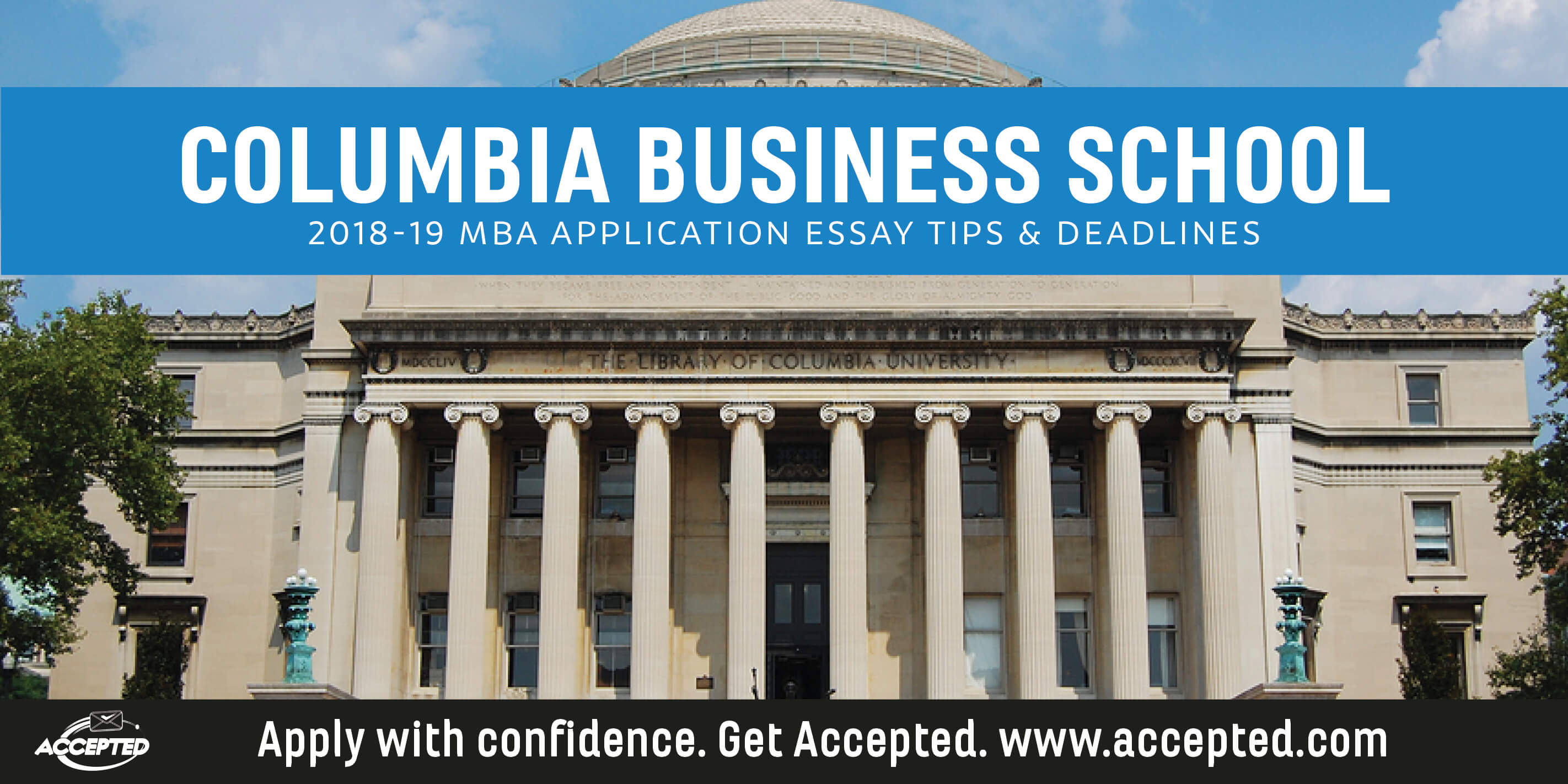  Columbia Business School has changed to two of its three required questions, leaving unchanged its short answer question, first essay question and optional essay question. Total word limits are the same as last year. The word limits are tight. Columbia Business School Application Essay Tips Goal: What is your immediate post-MBA professional goal? (50 characters) No changes with this question. Note, it is a character (not word) limit. Your response must be significantly less than a tweet. What do you want to do professionally and in which industry immediately after earning your MBA? Here are CBS’ examples of possible responses: “Work in business development for a media company.” “Join a strategy consulting firm.” “Launch a data-management start-up.” Warning: This question is not asking about intended area of study while in business school or a non-professional goal or even a long-term goal. And the subject in your response is assumed to be you. No need to waste characters by including “I.” Succinctly define your goal in terms of function (what you want to do) and the industry (or type of company) in which you want to do it. Columbia Business School Essay #1: Through your resume and recommendations, we have a clear sense of your professional path to date. What are your career goals over the next 3 – 5 years and what, in your imagination, would be your long-term dream job? (500 words) Columbia apparently liked the answers it received to this question, its longest, because it is back this year. CBS wants you to focus on your career goals not immediately after graduation, as in the short-answer question, but in the longer-term. They want to see how you believe your career will develop after that immediate post-MBA job. This question does not ask you how CBS will help you achieve your goals. To answer this question realize that the readers already know what’s in your resume. Don’t repeat “your career path to date.” That’s a waste of valuable essay real estate and means you’re not telling them anything new or answering their question. Do tell them what you want to do 3-5 years into the future, which should build on your first post-MBA job. Make sure to answer the long-term question and feel free to dream and aspire, but at the same time reveal an ambitious, but feasible professional goal. Columbia Business School Essay #2: How will you take advantage of being “at the very center of business”? (250 Words) Please watch thisshort video featuring Dean Glenn Hubbard [youtube2]p> Different from last year’s question, this year’s Essay 2 is very similar to the question that occupied this slot two and three years ago. Really think about the points these videos are making: What does being at the center mean? Access to an infinite variety of opportunities. Proximity to thought leadership and executive leadership. Convergence of theory and practice. NYC is an — if not the — international business center. After watching the videos, reflect on how you intend to take advantage of the myriad opportunities and energy that reside at Columbia University and in New York City. How will you benefit from the entrepreneurial eco-system in New York and Columbia University? The ties to bio science and pharma? Madison Avenue? The cutting-edge research and thought leadership? Not to mention the practitioners who lead Wall Street and teach at Columbia. Or will you explore the cultural riches of NYC and take advantage of the incredible business opportunities present in the arts and media? Be careful not to speak of those opportunities in the generalities that I have. If you are interested in luxury goods marketing, as stated in your short answer, then write here about how you will take advantage of Madison and 5th Avenues as well as Columbia’s offerings. If you are interested in finance or consulting, Manhattan and all the businesses in it are at your feet. How will you benefit from this incredible location as well as the practitioners teaching at CBS and the strengths of Columbia’s curriculum and program? Be specific.Final point: you don’t have to address all the points raised in the videos, but you do have to write persuasively about at least one. Columbia Business School Essay #3: Please provide an example of a team failure of which you have been a part. If given a second chance, what would you do differently? (250 words) First of all think about what causes teams to fail. Accepted consultant Natalie Grinblatt Epstein brilliantly and briefly explores that topic in “Get a GRIP on Team Questions.” Secondly, realize that CBS is looking here for applicants who can examine their actions critically, learn from mistakes — both their own and others, and take responsibility for errors of commission and omission. In your response, succinctly describe the failure. analyze its causes, and what you would do differently. If you have room and an appropriate example, conclude with a later team experience when you successfully implemented the lesson you learned from the earlier team failure. Columbia Business School Optional Essay: Is there any further information that you wish to provide the Admissions Committee? If so, use this space to provide an explanation of any areas of concern in your academic record or your personal history. This does not need to be a formal essay. You may submit bullet points. (Maximum 500 words) Clearly you can use this optional essay question to address a weakness in your profile or qualifications, but in my mind, this question is also open-ended enough to allow you to discuss a challenge overcome in your personal background. Don’t use this essay as a grand finale or wrap up. And definitely don’t use it to rehash your reasons for wanting to attend Columbia; those reasons should be perfectly clear from the required essays. If you would like professional guidance with your Columbia Business School MBA application, please consider Accepted’s MBA essay editing and MBA admissions consulting or our MBA Application Packages, which include advising, editing, interview coaching, and a resume edit for the CBS MBA application. Columbia Business School 2018 Application Deadlines: 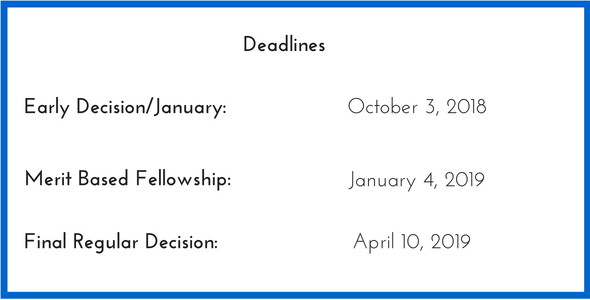 ***Disclaimer: Information is subject to change. Please check with individual programs to verify the essay questions, instructions and deadlines.*** 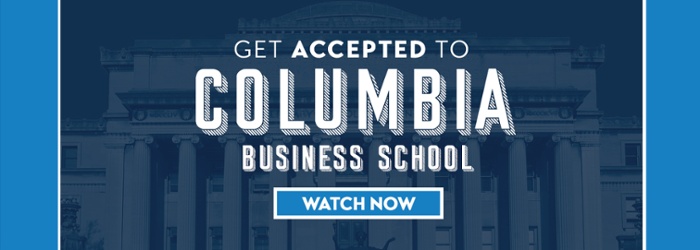  By Linda Abraham, president and founder of Accepted and co-author of the definitive book on MBA admissions, MBA Admission for Smarties: The No-Nonsense Guide to Acceptance at Top Business SchoolsTop MBA Essay Questions: How to Answer Them Right, a free guide • Podcast Interview with the Columbia Business School Admissions Team, a podcast episode • What Does “At The Very Center of Business” Mean for CBS Applicants? Tags: MBA Admissions The post Columbia Business School MBA Essay Tips & Deadlines appeared first on Accepted Admissions Blog. |
| FROM Accepted.com Blog: MBA Letters of Recommendation: Who, What, Where, When & How |
  Selecting your recommenders requires a strategy. I like to begin with the basics: Who, What, Where, When, and How. I also like to suggest that you waive your right to access it. The waiver makes the recommendation more credible to the admissions committee. Who? Who are the best people to address the questions the schools are asking? Who are the best people to affirm what you say and also add information that you don’t have the chance to include in your application essays? Many schools ask that a supervisor writes your LOR, and while that is ideal, there are times when you just can’t ask a supervisor for a letter. If you find yourself in that situation, you’ll need an explanation. For example, “I asked my mentor [instead of my supervisor] to write my recommendation because she knows my leadership, drive, and work ethic better than anyone else I know.” Or, “I’ve asked a former supervisor to write my recommendation letter because asking my current supervisor would jeopardize my current project/promotion.” Or, “I’ve asked a supplier to write my recommendation because my supervisor has only been on board for one month and I’ve known my supplier for three years.” Regardless, develop a strong relationship with your recommender prior to “the ask.” What? Many schools ask similar questions, but it is best to use the unique e-form each school provides the recommender and answer the questions the school asks. You will add the recommenders’ contact information on your application, and the school will send your recommender a link. Many of these documents can be written in Word and then uploaded. Often the questions will ask about your leadership in relation to your peers or when did your recommender offer you criticism and how did you receive the criticism? This latter question has been problematic for many recommenders. I suggest that the recommender think about the question in a different way: rather than thinking about a weakness, think about a time the recommender “offered the candidate advice and how did the candidate act on that advice.” A letter of recommendation is not your annual review; it’s your recommendation. Your recommender may even ask you to write the letter, and they’ll just sign it when you’re done. You need to stand your ground and say, “The school really wants your honest perspective, and I would be so grateful to you for your original work.” However, you can coach your recommender by providing: • A list of the schools you are applying to and the reasons why • A copy of your resume • Your goals statement • Additional items you want your recommender to cover (like your achievements or items that you can’t cover in your essays but that your recommender can elaborate on, like your affinity for paragliding or your talent with the cello) You can also ask your recommender to highlight achievements that may counteract a negative – like your communications skills if you have a low verbal score or a quantitative achievement if you have a low quant score. I know when I write letters for my former students, having this information will remind me of the great things that the student did for the school or for me. It gives me the launching point to tell a story. All the statements a recommender makes should be backed up with evidence (a story) to make it more interesting and hammer home the point of the recommendation. Many recommendations also offer grids. Your recommender should be honest. Where? If your recommender says they don’t have the time to write the recommendation, I’ve suggested my clients book a one hour appointment with the recommender (after they give the packet of materials needed to write the recommendation) and then call the recommender and say that they’d like to use this hour to write the recommendation. You can also offer to do things like pick up dry cleaning or groceries, walk the dog, or drive carpool to make time in your recommenders’ schedule to write the letter. Regardless, they need at least one hour of quiet time to get this right. When? It’s best to ask your recommender to write the letter at least six weeks prior to your anticipated date of submission. Everyone will face delays, so allow for them. Six weeks should give your recommender enough time to: 1. Review your preparation materials (see What? above) 2. Meet with the recommender for the request (in person if possible) 3. Meet again to give the packet of information that you will provide 4. Meet again to answer any questions the recommender may have for you How? If your recommender says that they can’t write a strong letter for you, you need to find another recommender. If they enthusiastically say “yes!” make the task easy for them by giving them the packet of helpful information (as mentioned in the What? section). Check out our Letter of Recommendation assistance service for more information on how we can help you and your recommender create strong LORs that will get you ACCEPTED. 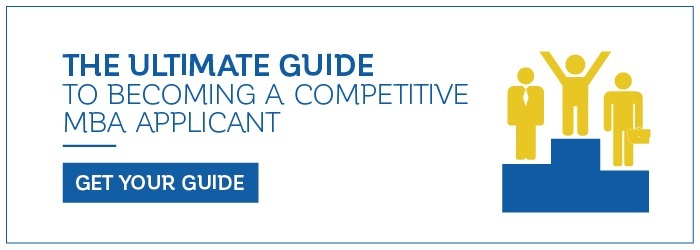  By Natalie Grinblatt Epstein, an accomplished Accepted consultant/editor (since 2008) and entrepreneur. Natalie is a former MBA Admissions Dean and Director at Ross, Johnson, and Carey. Want Natalie to help you get accepted to business school? Click here to get in touch! Related Resources: • Why MBA?, a free guide • How to Get Really Great Recommendations, a podcast episode • All You Need to Know About Recommenders & Recommendations Tags: MBA Admissions The post MBA Letters of Recommendation: Who, What, Where, When & How appeared first on Accepted Admissions Blog. |
| FROM Accepted.com Blog: How to Write the Qualifications Summary for Your Resume |
  The Qualifications Summary section of the resume is, in theory, the first section of the resume that the admissions reviewer will read: it sits at the very top of the resume after the applicant’s name and contact details, exactly where the eye is naturally drawn. However, if it is a bulky paragraph filled with ambiguity or wordiness, the reader may just skip right over it. For that reason, it is essential that your Qualifications Summary remains short, sweet, and to the point. What is particularly fun about the Qualifications Summary is that there really are no rules for its appearance (other than being short, sweet, and to the point). The general purpose of the section is to highlight the most impressive details, which may otherwise not stand out. That way, examples of the applicant’s exceptional impact immediately strike the reader, enticing them to continue reading out of interest and not out of obligation. What to Include in Your Qualifications Summary Here are some suggestions of elements you can include in your Qualifications Summary, depending on the length of your resume and the space you have to work with (a longer resume will eat away at the space set aside for your QS): • A short personality summary and/or career history For the former, you’ll be offering a snapshot of WHO the person is behind the WHAT of what you’ve done; for the latter, you’ll be using this space truly as a summary of what’s to follow in the rest of the resume – a little taste of what’s to come. • Core competencies or skills Keep in mind that for a one-page document, this is most likely an unwise use of space. If you do decide to include these, highlight the keywords that recruiters in your field will be seeking, not a slew of technology acronyms. • Achievement highlights Include a few notes about some highlights from your professional life – not where you’ve worked, necessarily, but the impact you’ve had. This is a very effective use of this space. • Anything notable in your past that is relevant to the role or program you are applying for This is especially useful for projects and impacts that occurred further in the past and would otherwise be buried near the end of the resume. • Testimonials or endorsements You can include snippets of testimonials from written recommendations or employment reviews by superiors and peers. This is not generally appropriate for an admissions resume but does often generate interview invitations in a professional job application. How to Get Started Writing Your Qualifications Summary To create your Qualifications Summary, first put together the rest of the resume: the professional experience, education, extracurricular activities, etc. Then go through and manually highlight the accomplishments and details that you think are especially relevant to the position or program you are applying to. For instance: • If you earned three promotions in two years – four years in advance of the traditional path for your company – this is something that will particularly interest the admissions committee or HR team. • If you initiated and successfully led a new venture from within your organization, then the effort and its impact are worth bringing to the top of the page. • If you feel you have a unique attribute that will position you to succeed in the role for which you are applying, differentiating you from all the other applicants, then insert that as well. • If there are a set of skills that you have gained that are essential to your target role, list them here. Choosing What to Write and Making It Look Good The challenge is deciding among the multiple items that could fit here to choose what will truly captivate the reader. As you decide what to include, remember to change the text in the sections below so that the document is not repetitive. For instance, if you highlight a project from your current work in a couple of lines in the Qualifications Summary, use only one line – and perhaps alternate statistics about it – to summarize it in the Professional Experience section. Finally, play with the layout to make this section readable and appealing. You can use text boxes, bullets, indentations, bold text, or titles to divide the material into short, legible “sections within the section.” Remember the key elements of including white space, keeping bullet points concise, and including numbers to quantify the size and scope of your projects. These will help your Qualifications Summary do the heavy lifting it is meant to! Do you need help with your Qualifications Summary, your full resume, or any other element of your application? Check out our Admissions Services and work one-on-one with an expert advisor who will help you get ACCEPTED! 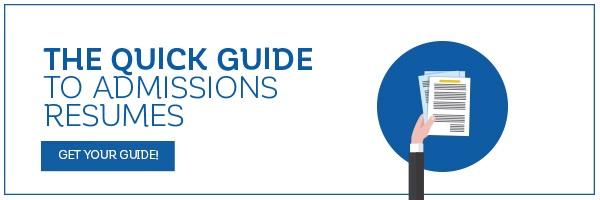  Jennifer Bloom has been a consultant with Accepted for 19 years and is a Certified Professional Resume Writer (CPRW). She is an expert at crafting application materials that truly differentiate you from the rest of the driven applicant pool. If you would like help with your application, Jennifer can suggest a number of options that work with any budget. Want Jennifer to help you get accepted? Click here! Related Resources: • Fitting In & Standing Out: The Paradox at the Heart of Admissions, a free guide • Aligning Your Resume With Your Application Essays • 6 Fatal Resume Flaws to Avoid Tags: Admissions Consulting, College Admissions, Grad School Admissions, Law School Admissions, MBA Admissions, Medical School Admissions The post How to Write the Qualifications Summary for Your Resume appeared first on Accepted Admissions Blog. |
| FROM Accepted.com Blog: Stanford GSB MBA Application Tips & Deadlines |
  Stanford takes top prize for being the most difficult MBA program to get into. Per US News it has a daunting 5.7% acceptance and the highest average GPA and GMAT score for the class that entered in Sept. 2017 of any U.S. MBA program. No wonder it tops Accepted’s B-School Selectivity Index. In terms of placement, Stanford GSB grads are prized, and rewarded handsomely. Its Class of 2017 started their careers with an eye-popping average annual salary of $159,440, second only to Wharton’s $159,815. Furthermore, 16% of Stanford’s MBA grads started their own business immediately upon graduation. In terms of its application, Stanford is once again re-using its essay questions. And there’s good reason for the recycling: These are excellent questions that succinctly get to the heart of what Stanford wants to know about you. They are not easy questions, but they are thoughtful, probing ones. Stanford gives a lot of advice and guidance on its website as to what it’s looking for in the essays. You should access that advice in addition to reviewing my suggestions below. My tips are in blue below. Stanford GSB 2018-19 MBA Application Questions: Essays help us learn about who you are rather than solely what you have done. Other parts of the application give insight to your academic and professional accomplishments; the essays reveal the person behind those achievements. When writing your essays, resist the urge to “package” yourself into what you think Stanford wants to see. Doing so will only prevent us from understanding who you really are and what you hope to accomplish. The most impressive essays are the most authentic. We request that you write two personal essays. The personal essays give us glimpses of your character and hopes. In each essay, we want to hear your genuine voice. Think carefully about your values, passions, aims, and dreams prior to writing them. Stanford MBA Essay A: What Matters Most To You, And Why? For this essay, we would like you to: • Do some deep self-examination, so you can genuinely illustrate who you are and how you came to be the person you are. • Share the insights, experiences, and lessons that shaped your perspectives, rather than focusing merely on what you’ve done or accomplished. • Write from the heart, and illustrate how a person, situation, or event has influenced you. • Focus on the “why” rather than the “what.” This superficially straightforward question has been Stanford’s first for at least the last sixteen years, but it is actually one of the most difficult, if not the most difficult MBA essay questions to answer. Superficial responses will fail. The prompt demands introspection. Before you put finger to keyboard or pen to paper, really reflect on what you value, how you have acted upon those principles, and why you live by them. Stanford’s advice urges reflection. The question requires it. When I reflect on our many successful Stanford clients, initiative in the face of need is the common thread among them. They are always the ones who revealed, especially in Essay A, that they do not turn away when they see a problem or need for action. They grab the initiative when faced with an opportunity to contribute. They are comfortable expressing emotion and their values, and their actions reflect both, but particularly the latter. Think purpose-driven, principled lives and leadership. More than anything else, initiative and self-awareness characterize the successful Stanford applicant. Implication: You have to know your values and those times you have acted upon them. Yes I wrote that a few seconds ago, but it bears repeating. Climbing Mt. Everest or suffering from terrible social ills is not a requirement of admission, but you do have to know the person occupying your skin. Stanford MBA Essay B: Why Stanford? Enlighten us on how earning your MBA at Stanford will enable you to realize your ambitions. • Explain your decision to pursue graduate education in management. • Explain the distinctive opportunities you will pursue at Stanford. • If you are applying to both the MBA and MSx programs, use Essay B to address your interest in both programs. Now that question is succinct, and really says what they want to know. This question is a variation of a standard MBA goals question, as revealed in the bullet points after it. For this forward-looking question, you need say why you want an MBA. The best way to do so is in terms of your desired post-MBA professional direction. Then explain how Stanford’s program specifically will help you travel down that path. Note the bullet point about the “distinctive opportunities you will pursue at Stanford.” Do your homework. You need to know what are the distinctive characteristics of the Stanford MBA program or you simply can’t answer the question. Understand the flexibility inherent in Stanford’s curriculum, its integrated approach to management, its entrepreneurial culture, and how all these elements (and others) will help you learn what you need to know to achieve your career goals. Realize that the curriculum allows for personalization based on your goal and your past experience, specifically your previous business education. Two pieces of information are required to answer this question: A clear MBA goal and an in-depth understanding of Stanford GSB’s curriculum. (Folks: It’s not just the ranking, brand, or location.) Please do NOT write that you want to attend Stanford because of “the flexibility inherent in Stanford’s curriculum, its integrated approach to management, its entrepreneurial culture….” That phrasing is too general for your specific reasons (and besides the Stanford adcom can google the phrase if they see it too often and see that you found it here). Go deeper and be more distinctive in your writing so that you really tie your goals to different facets of Stanford’s program. Stanford also asks that if you are applying to both the Stanford MBA and MSx programs, you use Essay B to address your interest in both programs. It gives those applying to both programs an extra 50 words to address that interest. Essay Length: Your answers for both essay questions combined may not exceed 1,150 words (1,200 words if you are applying to both the MBA and MSx programs). Each of you has your own story to tell, so please allocate these words between the essays in the way that is most effective for you. Below is a suggested word count, based on what we typically see. Essay A: 750 words Essay B: 400 words Essay B (if applying to both the MBA and MSx programs): 450 words Formatting: • Double-spaced • Indicate the question you are answering at the beginning of each essay (does not count toward the word limit) • Number all pages • Upload one document that includes both essays Be sure to save a copy of your essays, and preview the uploaded document to ensure that the formatting is preserved. For expert guidance with your Stanford MBA application, check out Accepted’s MBA Application Packages, which include comprehensive guidance from an experienced admissions consultant. We’ve helped hundreds of applicants get accepted to Stanford’s MBA program and look forward to helping you too! Stanford GSB 2017-18 MBA Application Deadlines: 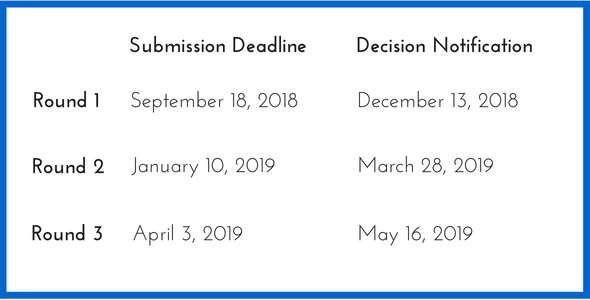 ***Disclaimer: Information is subject to change. Please check with individual programs to verify the essay questions, instructions and deadlines.*** 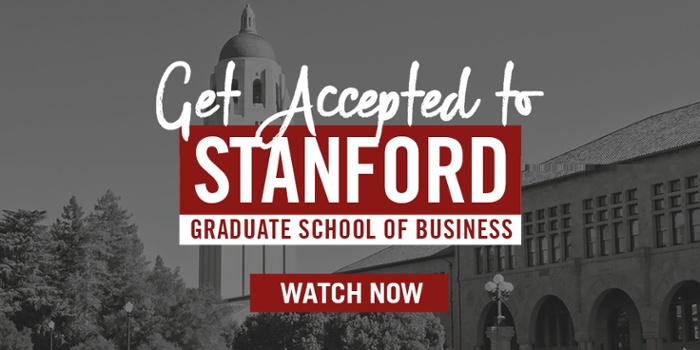  By Linda Abraham, president and founder of Accepted and co-author of the definitive book on MBA admissions, MBA Admission for Smarties: The No-Nonsense Guide to Acceptance at Top Business SchoolsWhy MBA?, a free guide to writing about your MBA goals • What Stanford GSB is Looking For • Harvard, Stanford, Wharton: What’s the Difference?, a short video Tags: MBA Admissions The post Stanford GSB MBA Application Tips & Deadlines appeared first on Accepted Admissions Blog. |
| FROM Accepted.com Blog: MIT Sloan EMBA and Sloan Fellows Programs: Move from Success to Significance |
 MIT Sloan Executive Education [Show Summary] Today we’re going to look at executive MBA program options: MIT Sloan’s executive MBA program, which is relatively new, but more typical in structure; MIT’s part-time MBA program; and the MIT Sloan Fellows program, a full-time immersive executive MBA program. We are going to learn about them from Johanna Hising DiFabio, Director, Sloan Fellows and EMBA Programs. Interview with the Director of MIT Sloan EMBA and MIT Sloan Fellows Programs [Transcript] Johanna worked in business after earning her undergraduate degree from Ithaca College in 2000. She came to MIT Sloan as Associate Director of Student Life and Learning in 2010, became Director of MIT’s EMBA program in 2014, and added the Sloan Fellows program to her responsibilities in 2017. Johanna, can you provide an overview of both programs, the MIT EMBA and the MIT Sloan Fellows program? [1:54] The Sloan Fellows program, at over 80 years old, is I believe the oldest executive degree program in history. It’s a one-year, mid-career, intensive fulltime program. Our students come from all over the world for a year to study a curriculum in general management. They start in the summer, and in the fall and spring they have lots of electives to choose from if they want from within the full-time program, as well as other opportunities to fully immerse at Sloan and MIT. Eight years ago we started the EMBA program. We were a little late to the market with this degree in comparison to other universities out there. We started it with the aim of the curriculum being heavily action-learning focused. Students come every second or third Friday/Satday and spend six hours a day in class with the focus on going back to work on Monday and applying what they’ve learned. It is a 20-month executive program, and we are looking for general managers with experience managing teams and managing businesses. The EMBA program provides an opportunity to earn a general management degree with a few electives but not as many as Sloan Fellows has. What do the two programs share and where do they differ? [3:50] They share the core general management curriculum, and with both degrees we expect significant work experience coming in. Both programs also have fantastic cohorts – we hear that across the board. One aspect where they differ is on the EMBA side we expect them to have a job and be working, while with Sloan we expect them to not be working and fully immerse themselves in the program. The Sloan Fellows program is 12 months vs 20 months for the EMBA program. Sloan Fellows also offers many more elective opportunities, while the EMBA is fairly lock step and action learning focused to apply their learnings immediately. On the EMBA side 45% of students are born outside of the US but the vast majority are working in the US, and with Sloan Fellows 75-80% of the population is from outside the US, with most bringing their families. Neither program requires financial sponsorship, but of course time sponsorship is required for both. MIT puts a strong emphasis on innovation. How does this strong emphasis on innovation play out in each of the two programs? [6:43] There is innovation in the content students are taught. In the core there is an innovation-driven advantage in Sloan Fellows, and on the EMBA side there is entrepreneurial-driven innovation. I would also say that on MIT’s campus, innovation is in the air. There is constant conversation between faculty and students, and we bring students to labs to see what faculty and post-docs are working on. We also look for an innovation mindset in the admissions process. Can you provide an example of someone who used either of these two programs as a springboard either to entrepreneurship or career change? [9:03] We have a summer accelerator, and we have three Sloan Fellows’ companies involved in it and one EMBA’s company this year. We have companies that get started here- students come in with ideas and then further develop them while in the program. I would say 50% of those students come in having been entrepreneurs and the other 50% are looking at dipping their toes in this area. On the other hand, in terms of career transitions, I am stealing this line from one of our alums, “Students come to MIT executive degree programs because they want to move from success to significance.” That says it all to me. Is there career guidance given in the Sloan Fellows program? And with EMBAs in general not known for facilitating career change, can you talk a little about how the Sloan EMBA has assisted career change.? [11:41] We have a Bring Your Boss to Campus day with the EMBA program, and with Sloan Fellows we have companies coming on campus all the time. We make it very clear that people don’t give up time away from work to not have some sort of advancement, so it is up to the organization to figure out how to provide that advancement. If companies don’t provide it, they can’t blame students for looking elsewhere. What we provide at Sloan is career-strategic advice. What we are trying to do is provide them with the skills and knowledge to be very strategic about where they want to go in their careers. How do they think about their career? How do they make a good resume? How do they create a good LinkedIn profile? What about their network – which at this point is one of the most important aspects to advancement in their career? We provide guidance on those types of things. We have recently hired a new Director of Career Coaching, and I am really excited about the opportunities provided there. One thing we don’t offer is the opportunity to go through the typical recruiting process as a full-time student does, with interview signups and the like. Recruiting at the executive level doesn’t work like that. We are looking at people with 14-17 years of work experience, so I don’t have a homogeneous population going into homogeneous roles, and recruiters have less interest in coming to campus because they have five roles they are looking for the same type of person to fill. It is much more about networking than anything else. How much mixing (if any) takes place among MIT Sloan MBA and MIT EMBA and Sloan Fellows students? Between the two programs that you direct? [14:45] Scheduling is always a challenge. Everyone is super busy. We have a student life office, and they are always trying to create opportunities for cross-networking. That happens with Sloan Fellows more often because they are in classes with some of the two-year MBAs, but also with the Sloan Fellows and EMBAs we have events together. But students want more and we always want to try and do more. What makes an application to the MIT Sloan EMBA program jump off the page (in a positive way)? [15:54] Unfortunately I don’t have the silver spoon for that. It is a combination of things. We want to see a minimum of ten years of experience. From there, we look for someone who has led teams and/or businesses, and typically is an industry expert, is quant-comfortable, and has a story to tell. We are very interested in creating a diverse community, so we look for a variety of backgrounds and experience, as well as impact in the world and the interest in creating positive change in the future. We also want someone who can work well with others. For Sloan Fellows the profile we are looking for is very similar, though we do look a little younger, at times 8-9 years, but we still want general management experience or perspective. We read the application from cover to cover, and we want to learn as much about you as possible, so use new examples. What are mistakes applicants make in their application to the MIT Sloan EMBA and Sloan Fellows programs? [17:38] I would say it’s very similar for both programs. The first mistake is sharing information they think we want to hear vs information that reflects who they are. Also, MIT is very merit-based, so I want references who have worked with you in the past who can provide examples. If it is someone who has graduated from MIT and knows the culture and has worked with you, great. But if it is someone who graduated from MIT but has never worked with you, we don’t find that very helpful. Those are the two biggest mistakes I see. What do applicants not get about either program? [18:41] I think it’s the people. The students are just fantastic on both sides. I often say you will learn just as much from the students as you will from faculty. As cheesy as it may sound, they become family. You will be able to rely on these people for the rest of your life. When you have an opportunity or challenge you can reach out to them and you will have support from all around the world. What additional advice do you have for applicants to your program? [19:55] I highly recommend talking to a current student or alum, starting with registering interest on our website. Our admissions advisors would be happy to connect you with someone. No one can talk about this program like our students and alums, and the more transparent we can be the better. What do you see coming down the pike for these two programs? [21:10] We are constantly innovating. We like to change and are constantly gathering insights from students and faculty. One aspect is how do we get more data into our classes? This year we added a Data Analytics Certificate, and at graduation we had 30 Sloan Fellows and 10 EMBAs with this certificate. There is a lot of talk about fintech and blockchain, and we are looking at those types of pieces of content being added to the curriculum.  Related Links: • Ace the EMBA: Expert Advice for the Rising Executive • MIT Sloan Executive MBA Essay Tips & Deadlines • MIT Sloan Fellows Essay Tips & Deadlines • MIT Sloan Fellows • MIT Executive MBA Related Shows: • MIT Sloan Fellow, User Experience Expert, and Busy Mom • Meet Dr. Nadia Afridi, Plastic Surgeon, Recent Columbia EMBA, and Mom • MIT Sloan Fellow, User Experience Expert, and Busy Mom • Excellent Executive MBA Admissions Advice • A Lot About Yale SOM’s EMBA Program – And a Little About One Year MBAs Subscribe:   Podcast Feed 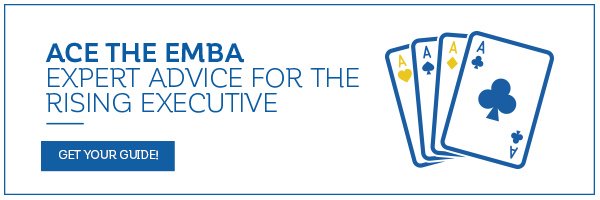 Tags: Admissions Straight Talk, Grad School Admissions, MBA Admissions The post MIT Sloan EMBA and Sloan Fellows Programs: Move from Success to Significance [Episode 263] appeared first on Accepted Admissions Blog. |
| FROM Accepted.com Blog: Yale SOM MBA Essay Tips & Deadlines |
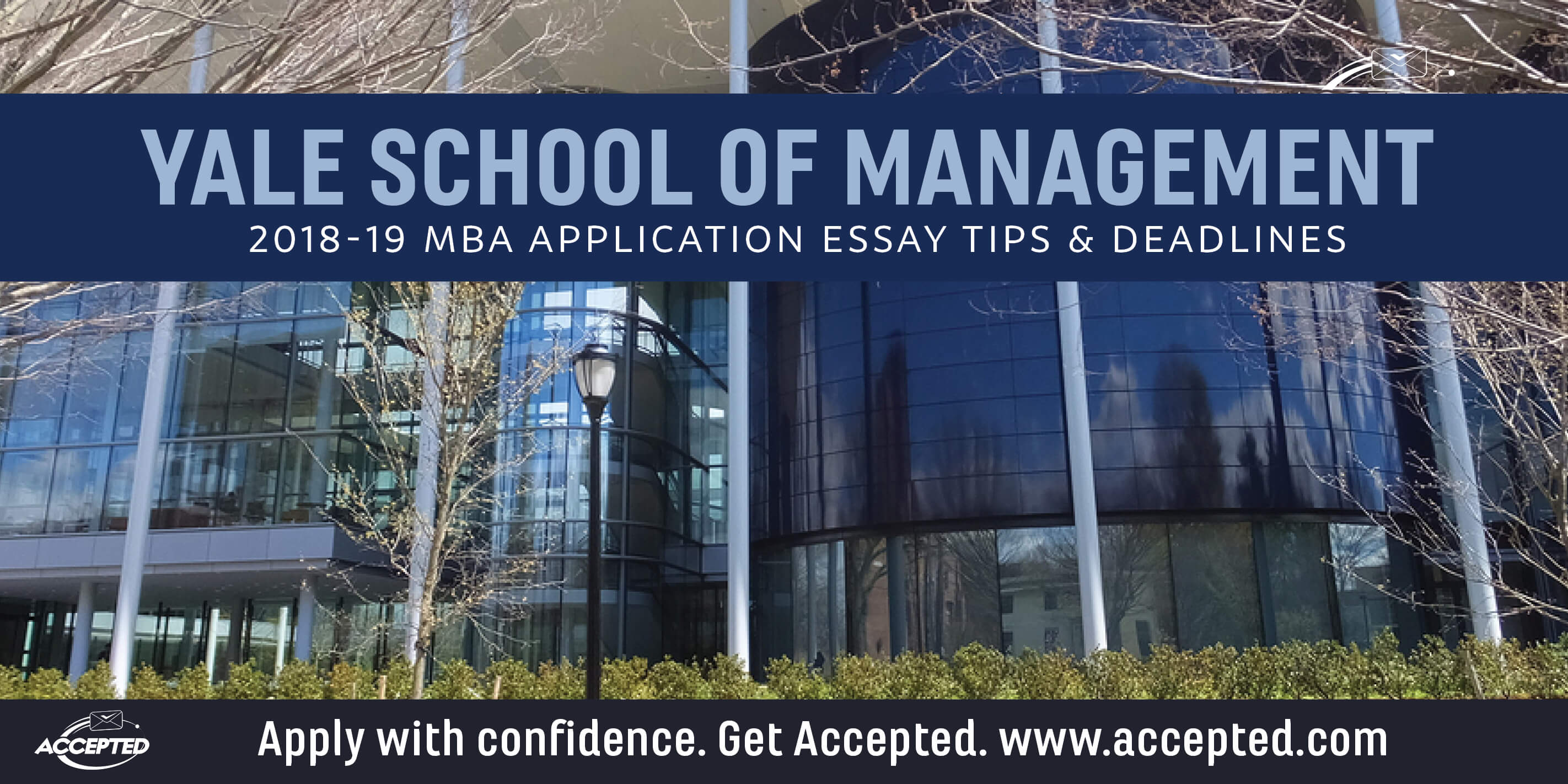 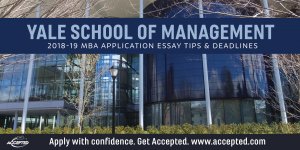 Although its application is the same as last year’s MBA application, Yale School of Management is in transition. Its innovative, dynamic dean, Edward Snyder, is stepping down from the deanship at the end of the 2018-19 academic year. Dean Snyder oversaw the construction of Yale SOM’s gorgeous new facility, launched Yale School of Management’s Global Network for the Advancement of Management, and added a Masters of Advanced Management degree to Yale’s degree options in graduate management education. The application has little change from last year. As applicants have done for the last few years when applying to Yale SOM, you need to make the most of its single required essay, but you also need to take the time to make every box in the application a home run. They are not afterthoughts. Your job descriptions and activity history are very important. Write and edit them carefully. Focus on achievements. Quantify when possible and keep in mind Yale’s commitment to “educating leaders for business and society.” My tips are in blue. Yale SOM Essay Question: Describe the biggest commitment you have ever made. (500 words maximum) The question is based on the premise that actions speak louder than words. So if you make a commitment, do you follow through? Do you make big commitments? What are the results? What impact have you had as a result of your biggest commitment? Your essay would do really well with an anecdotal response telling the story of the commitment you made. What was the challenge or problem that triggered it? How did you follow up? What was the outcome? The effect and significance? Did you successfully solve that initial problem or achieve your goals in meeting that challenge? You can start with the moment of challenge or the moment of triumph. If you choose the latter, then go back, provide context, and tell your story of commitment, resolve, hurdles overcome, and challenge handled. If the impact has lasted – on you and others – succinctly include that part of the story too. Yale SOM Application Video Component Yale also has a video component to its application. The questions are not posted ahead of time and they vary from applicant to applicant. The key element to preparation here is practice. Practice talking into a webcam without feedback from another human being. Practice the 60-90 second time frame. Rehearse answers to typical interview questions in this format. Remember the STAR (Situation – Task – Action – Result) or CAR (Context/Challenge – Action – Result) framework in structuring your answers. Yale suggests that you practice via Skype with a friend, but have them turn off their webcam and just provide feedback at the end of your response. I also suggest you put a smiley face somewhere so you can see it and remind yourself to smile. If you would like professional guidance with your Yale MBA application, please consider Accepted’s MBA essay editing and MBA admissions consulting or our MBA Application Packages, which include advising, editing, interview coaching, and a resume edit for the Yale SOM application. Yale SOM 2018-19 Deadlines: Application Deadline Decisions Released Round 1 September 12, 2018 December 5, 2018 Round 2 January 7, 2019 April 2, 2019 Round 3 April 16, 2019 May 21, 2019 ***Disclaimer: Information is subject to change. Please check with individual programs to verify the essay questions, instructions and deadlines.***   By Linda Abraham, president and founder of Accepted and co-author of the definitive book on MBA admissions, MBA Admission for Smarties: The No-Nonsense Guide to Acceptance at Top Business Schools5 Fatal Flaws to Avoid in Your MBA Application Essays, a free guide • An Electrical Engineer from Ghana Makes His Way to Yale SOM •How Can You Show Passion in Admissions? Tags: MBA Admissions The post Yale SOM MBA Essay Tips & Deadlines appeared first on Accepted Admissions Blog. |
| FROM Accepted.com Blog: Optimize Your LinkedIn Profile for Your MBA Application |
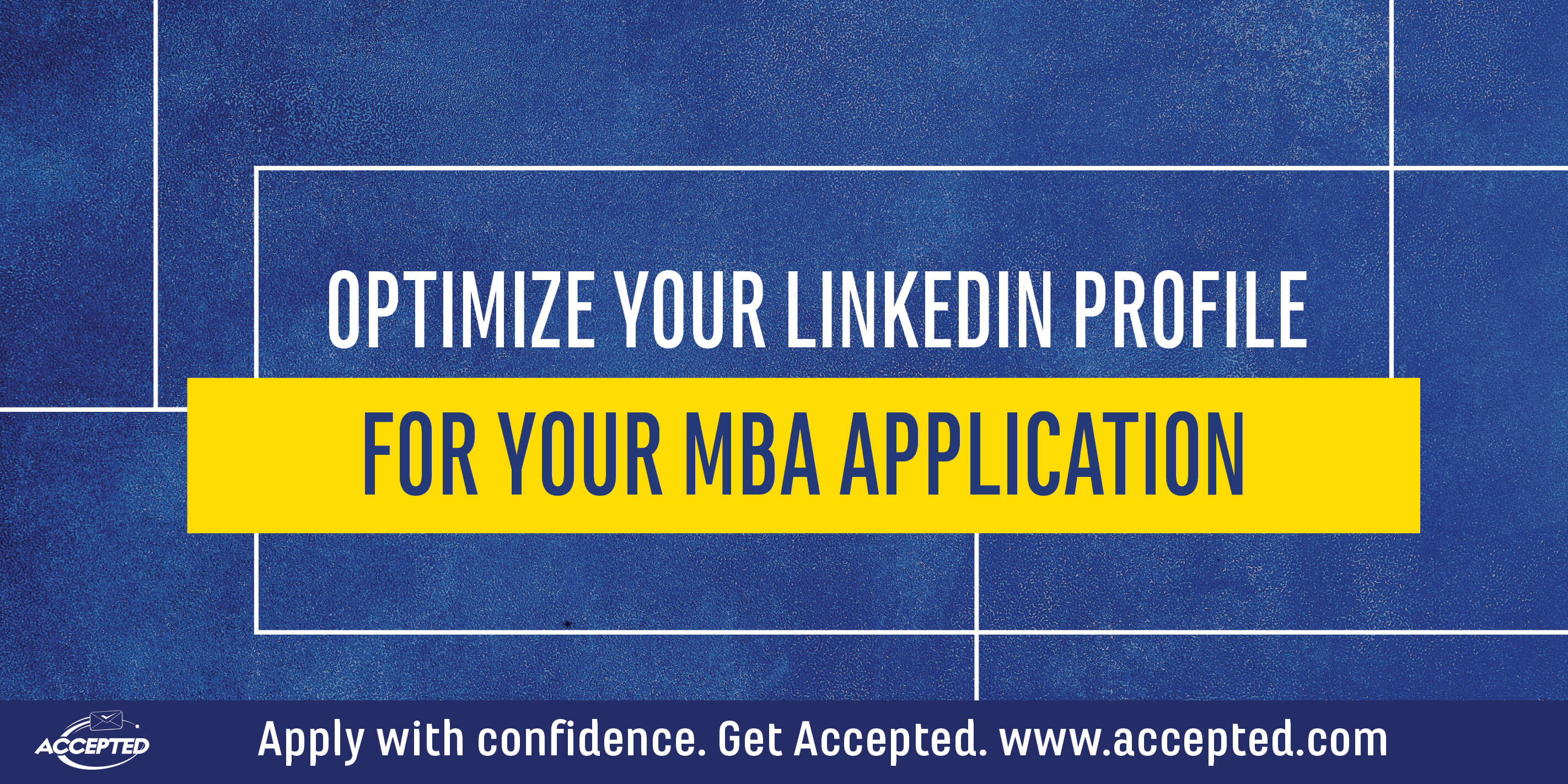  Does LinkedIn hold the key to your acceptance? The Cornell Tech MBA made waves when it offered applicants to its unique program in New York City the opportunity to apply with their LinkedIn profiles instead of filling in the tedious employment history section of the application. Other MBA programs like MIT Sloan and UT Austin McCombs are following that trend by inviting applicants to share their LinkedIn profile URLs in their applications. While I don’t believe that every applicant’s LinkedIn profile is going to be fully studied, we at Accepted view any additional space to share more about your background with the admissions committees as an opportunity to make your case of admission even stronger. We highly recommend that you update your LinkedIn profile and share the link in the application when offered the chance to do so. Not only may the admissions office glance at your profile while reviewing your application, but your interviewer may check you out before meeting you in person. This is your opportunity to make a great first impression. There are five essential areas in the LinkedIn profile that constitute the bare minimum that you need to complete well as an MBA candidate: 1) Headline, 2) Summary, 3) Experience, 4) Education, and 5) Volunteer Experience. In this post, I will explain what to focus on in each of these sections and share some useful additional tools that LinkedIn offers. Section 1: Headline The headline is the description that is displayed under your name when you appear as a candidate in someone’s search. You have 120 characters to summarize who you are here, and if you don’t do so, the space will automatically be populated by your current professional title and company. If you are active in fields outside of your professional role, it makes sense to use this space to present a fuller picture. For example, if you’re an Analyst at an investment bank but founded and lead a non-profit organization in addition to that full-time role, then it makes sense to try to include both elements in the headline: “Analyst at Morgan Stanley and Founder of not-for-profit Social Innovation Corps.” This will immediately help you stand out from all the other IB analysts applying alongside you. Section 2: Summary The summary offers you 2000 characters to present a full picture of who you are: personality, interests, achievements, passions, and even ambitions. I recommend opening with your current work and most recent impacts in the first paragraph, and then share details of your character, outside interests, and other significant accomplishments in the subsequent paragraphs. Similar to a traditional resume’s Qualifications Summary, this section allows you to bring the most unique elements of your background right to the top for the reader. Section 3: Experience LinkedIn allows you to list every position you’ve held within a company separately but in my opinion, you need to assume that readers will not get far in perusing such a long profile. I recommend only listing your most recent role in each company and then using the 2000-character position summary to highlight the promotions you earned and the impacts you made throughout the company. The Experience section is where LinkedIn parts ways with a traditional resume: instead of using traditional impact bullet points as you would for a resume, LinkedIn works best in paragraph form, telling your story: What was happening in the business environment at the time? What challenges was the company or your unit facing? What actions did you take? Sharing the context surrounding your accomplishments will make those accomplishments even more impressive for the reader. Then, you can share your impact either continuing in paragraph form or in bullet points. There is one caveat here: LinkedIn is public; don’t share any information that is not already public or anything that would upset a colleague. Section 4: Education Since you are applying to graduate school, your involvement in your previous campus experience(s) is very relevant: if you were actively involved on campus and earned exemplary grades in the past, you are likely to do so again in your next university. Therefore, I highly recommend making full use of the space in LinkedIn’s education section to include the activities and leadership roles you held on campus and any excellent academic performance as well as the recognition you may have earned. Section 5: Volunteer Experience Finally, LinkedIn offers a Volunteer Experience section. For an application that allows no space in its online form to detail extracurricular activities (like in MIT Sloan’s application), the opportunity to highlight these non-professional roles and impacts here is extremely useful. If you are currently involved in a volunteer activity or social venture, you may wish to bring the experience to the top of your LinkedIn profile by including it in the Experience section itself; however, even if you do choose to keep the description to the separate Volunteer Experiences section – LinkedIn assuages some of the disappointment at the lack of space allowed for these experiences in the application. For professional guidance with your LinkedIn profile, Check out Accepted’s MBA Resume and LinkedIn Editing Services. 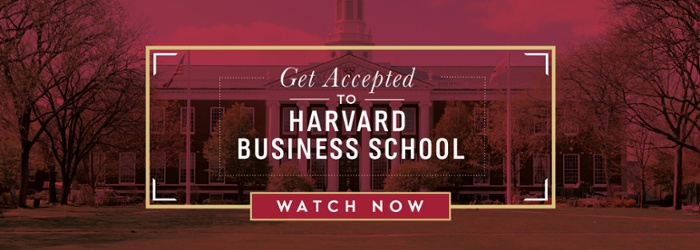  Jennifer Bloom has been a consultant with Accepted for 19 years and is a Certified Professional Resume Writer (CPRW). She is an expert at crafting application materials that truly differentiate you from the rest of the driven applicant pool. If you would like help with your application, Jennifer can suggest a number of options that work with any budget. Want Jennifer to help you get accepted? Click here! Related Resources: • The Ultimate Guide to Becoming a Competitive MBA Applicant, a free guide • The Increasingly Important Role of Social Media in the Application Process • What Does Your Work Experience Reveal About You in Your MBA Application Tags: MBA Admissions The post Optimize Your LinkedIn Profile for Your MBA Application appeared first on Accepted Admissions Blog. |
| FROM Accepted.com Blog: Should You Apply to a Safety School? |
  Many applicants who are targeting top ranked programs wonder if they should consider adding a lower-ranked school to their list as a “safety school.” Should you? And is there such a thing? What is a safety school? A safety school is one where you are highly competitive, that is strong in your area of interest, and where you will probably be accepted if you present your case well, but is not as competitive as higher ranked schools. The school supports your particular goals, but doesn’t have the overall brand value of some of the more competitive schools. It’s important not to fixate on a “star” name. If a school offers the type of program you’re looking for and you are a good fit in other ways, you should genuinely think about going there. Your application to a safety school needs to be taken as seriously as one to a more competitive school. Slacking off and submitting an incomplete or sloppy application will lead to your rejection even from a school in this category. How do you decide if a school supports your goals? First, separate out professional and educational goals by asking yourself the following questions: 1. For professional goals: • What you do you want to do after you receive your degree? • Are graduates hired in high numbers for the positions you would like to obtain? • Do the companies that you would like to work for recruit on campus? • Is the alumni network strong in your field? 2. For educational goals: • Does the curriculum teach you what you want to learn in the way you want to learn it? • What do you need to learn to pursue your chosen professional path? • Are professors at the school prominent in your area of interest? What if you know you only want to go to a top ranked program? First of all, rankings aren’t everything. But if you know that your top choice schools are the only ones for you (for any reason – academic, professional, geographical, etc.), then your decision is made for you. Are you guaranteed admission at a lower ranked school in every field? In some disciplines and degree programs, it is hard to talk about “safety schools” at all – if you’re applying to PhD programs, your “safety” strategy might be adding a couple of master’s programs to your list, or making a plan to get additional research experience before reapplying if your first applications don’t pan out. So what should you do? If you conclude that no safety schools meet the above criteria, then you shouldn’t bother applying to any. If you have a top-school-or-bust attitude, then that’s fine – just know that your chances of getting in will be lower and you may need to reapply next year (and if none of the less competitive schools are for you, then this is the right move for you). However, many of you will find programs where you are much more competitive and that do support your goals. They will be your insurance policy if you are applying with a less-than-perfect profile to programs with cut-throat competition. They may also prove to be more generous with financial aid. If you’d be thrilled to attend any of the safety schools on your list, then you should certainly apply to them. (In general, if you wouldn’t be happy to attend a program on your list, then you should immediately cross it off your list!) Whether or not to apply to a safety school, like so much in admissions, is determined individually. There are no across-the-board rules. Use the above criteria to guide you as you decide where to apply. And work with one of our experienced consultants if you need more personalized assistance. Our expert advisors can guide you through the entire admissions process – from choosing where to apply to helping you write awesome admissions essays to prepping for your interviews, and everything in between! Explore our Admissions Services for more information on how we can help you get ACCEPTED.   Related Resources: • From Example to Exemplary, a free guide • Can a Grad Consultant Help You Succeed? • Can You Get Into a Top Grad School if You Didn’t Attend a Top University? Tags: Admissions Consulting, College Admissions, Grad School Admissions, Law School Admissions, MBA Admissions, Medical School Admissions The post Should You Apply to a Safety School? appeared first on Accepted Admissions Blog. |
| FROM Accepted.com Blog: MBA Applicants: Time to Get Started! |
  You’ve been putting a plan together for a while now – researching business schools, taking the GMAT, reviewing your transcript, thinking about recommenders – and now is the time to put that plan into action. Top business schools are extremely competitive, with acceptance rates ranging from 5%-20%. Since you hopefully are already familiar with statistics (and if not, you will be your first semester of business school!), the earlier in the admissions cycle you apply, the greater your chance of admission. Business schools have released their applications for the 2018-2019 season, so there is no time like the present to begin the formal process of applying. To help you get started, from June 21-28 we are offering the following savings: • $100 off orders over $1000 • $200 off orders over $2000 • $500 off orders over $5000 • $1,000 off orders over $10,000 Use the code GETSTARTED at checkout. Get started on your MBA application today! Note: The coupon can’t be combined with another offer, is for non-rush orders only, and can be used one time only. Tags: MBA Admissions The post MBA Applicants: Time to Get Started! appeared first on Accepted Admissions Blog. |
| FROM Accepted.com Blog: 6 Tips for Creating Your Compelling MBA Goals Essay |
  Ask yourself this question: Is THIS the program that will help you reach your goals? Most schools ask why you want an MBA and why you want it from this school. And really, even if they didn’t ask you, you should still ask yourself. Before you invest the time and money in an MBA, you should know the answers to those questions. It’s not “just” an admissions question. Your Goal: To Identify Your Realistic, Relevant MBA Goals When you sit down to write a goals essay, your mission is to link your unique goals with the mission or goals of your target MBA program. You also have to show that your goals are anchored in your experience. (Usually you’ll make these connections in the goals essay, but sometimes, depending on the wording of the question and your particular history, you may do so in other essays.) Here are some tips to help you with this goal-linking process and get ready to write a stand-out goals essay: 1. Look at the school’s core curriculum It’s true that most b-schools have more or less the same type of courses in the core areas (finance, accounting, marketing, etc.), but they’ll cover these areas from different perspectives and in different ways. Do they use the case study method, or are they more project-oriented? Or do they use a mix of pedagogical methods? Is it a school that emphasizes the connections between different functional areas in business or does it rely on you to connect the dots – if you want to connect them? Do you want a structured program or do you want a highly flexible one that you will be able to mold to your specific needs? Which approach do you prefer and why? 2. Explore the clubs and activities There is definitely overlap between the schools in this area as well, but there are also specific clubs for niche industries and interests that are only found at certain schools. If you have a niche interest, then tie it to the niche clubs. For example, some schools, like Columbia, have Luxury Goods Clubs. That tidbit would be great to know if luxury goods product management or marketing is your goal. Look for the ways the school offerings are different, not the same. 3. Check out the special programs at each school Most top schools offer a global practicum, b-plan competitions, case competitions, etc. But you need to dig even deeper. They don’t all offer the same things and in the same ways. How will some of these special programs help you accomplish your goals? Where are the school’s ties? Is it near Wall Street with excellent IB connections? Or is it near a startup hub? Some have closer ties to Europe, some to Latin American, and some to Asia. Where are your interests? As an example: MIT has a great program in Entrepreneurship and Innovation – find out if it fits your needs and if it does, why and how? 4. Research the school’s faculty Which faculty would you like to study with? What are you really interested in? Who is doing cutting edge research in that topic? How could that research help you achieve your goals? 5. Keep an eye on a school’s commitment to community Keep in mind that community isn’t just geographic. It can be a community of interest, background, belief, profession. What have you done for your community, however you define it, recently? 6. Pay attention to student culture/personality Each b-school has its own persona that projects itself into the dynamic community that the school represents. That’s why visiting schools, attending school receptions, info sessions, and reading student blogs and school newsletters are so important. Each of these will give you insight into the schools’ cultures and personalities. Your goals essay is one of the most important components of your MBA application because it represents who you are, where you’ve been, where you’re going, and how your target program will help you get there. And we can help! Work one-on-one with an expert admissions advisor who will help you identify your goals, convey them in a compelling essay, and get you noticed by adcom at your top choice MBA programs. Learn more about our MBA Admissions Services here.   Related Resources: • MBA Admissions A-Z: 26 Great Tips, a free guide • How to Clarify Your Goals for Your MBA – And Beyond • 4 Things to Do If You Can’t Define Your MBA Goals Tags: MBA Admissions The post 6 Tips for Creating Your Compelling MBA Goals Essay appeared first on Accepted Admissions Blog. |
| FROM Accepted.com Blog: US News Rankings: Everything I Ever Wanted to Know (But was Afraid to Ask) |
  U.S. News Answers All Your Rankings Questions [Summary] Normally, when U.S.-based applicants talk about “the top programs,” especially when they refer to the top X, as in the top 10 or the top 20, they are referring to U.S. News Rankings, the granddaddy of educational rankings. Today we’ll hear from U.S. News Executive Editor, Anne McGrath, and Chief Data Strategist, Robert Morse. Interview with Anne McGrath and Bob Morse of U.S. News & World Report [Transcript] Linda: I’m so pleased to have on the show Anne McGrath, Executive Editor of U.S. News & World Report, and Robert AKA Bob Morse, Chief Data Strategist at U.S. News & World Report. Anne has been with U.S. News since 1985 and Bob has been with U.S. News since 1976. Both are pioneers in the realm of rankings. Now for all the questions I’ve ever had about rankings but was afraid to ask, and hopefully these are some of yours. I can actually get answers. Anne and Bob, welcome to Admissions Straight Talk. Anne: Thank you, good to be here. Bob: Thank you. We’re looking forward to doing our best effort to answer all your ranking questions. Here’s your chance to get U.S. News to answer them. Linda: I was just thinking that this is very unusual. Usually representatives of U.S. News are asking the questions, not answering them! And I’m usually the one reading about it. It’s a pleasure to have you here. I’m really looking forward to this and I appreciate your taking the time to join me. You’ve both been at U.S. News since the beginning of the college rankings, I think it was the 1980s, right? Around 1987 – correct me if I’m wrong. Bob: Yes. It actually started in ’83 and ’85. They were very short versions in the weekly magazine. 1987 was the first guide book. That’s when we started doing them annually. Linda: Can you give a little of the backstory – how did this get started? What criteria were there and how did you choose the criteria that you focused on? Has there been an evolution of the criteria over this period in the rankings? Bob: There has definitely been an evolution of the criteria. At first the rankings were based on reputation alone. College presidents picked their top 10 schools, and the schools that had the most mentions were the ones that were rated. ’87 was the last reputation-only ranking. Then we realized that for the rankings to become relatively more acceptable in higher education, we needed to bring in statistical data. We met with a lot of higher educators and came up with criteria to measure academic quality which is the basis for the rankings today. We knew that there was a big gap in needing consumer information on how to compare schools to each other, and we thought we could fill this gap by bringing in statistical and reputational data. At the beginning we put more emphasis on inputs, and recently we’ve been evolving to more emphasis on outputs – graduation and retention rates, etc. We’ve de-emphasized inputs like test scores and grades. Linda: Is that specifically for the college rankings or are you also talking here about the grad rankings? What are some of the differences between the two? Bob: The grad and college rankings are different for 2 reasons: The college rankings are at the institutional level only, meaning that we’re focusing on data that’s at the undergrad level. The graduate rankings are at the program level – the MBA degree, the medical school, etc. Each one has its own methodology that picks up characteristics of the program. Some of them are reputation only. For the college rankings, there are approximately 1400 schools using basically the same methodology, ranking factors, which are compared to schools that have similar characteristics. Anne: The undergraduate best colleges ranking isn’t just one ranking. It’s really 10 different rankings. National universities are ranked against themselves, national liberal arts colleges are ranked against themselves, etc. It gives people more options to compare schools to their own peer group, in a way you often can’t do just by doing your own research. Linda: It also gives people ideas as to what are peer schools. If school A appeals to you, but is too expensive or too far, you can find other similar schools that are less expensive or closer. Anne: One of the real values to readers is that you can see schools that you might never have known about and might be of interest. Bob: That was actually one of the bigger successes of the rankings. It has made people more aware of the variety of U.S. higher education. There’s still a lot of focus on top schools, but we made people more aware of the diversity of U.S. higher education because of using the categories. Anne: One of my favorite rankings is the A+ Schools for B students that correlates quality and academic excellence with the scores and grades in such a way that you can see what schools you can get into if you don’t apply with a GPA of over 4.0. Linda: That sounds very valuable. Is that available only online, or online and offline versions? Anne: Both places. Bob: Everything that’s in print is online, but the online version has far more data. The paid version has the fullest rankings and data. Linda: Just to clarify for myself, as well as for listeners. Bob, it seems to me that you’re the statistical guru behind the rankings. You make sure that everything is correct and meaningful and provides something of value. Anne, will you go a little bit into what your role is? Anne: Sure. I’m the editor overseeing the publication of our print guidebooks. An advantage of seeing the rankings in print is that you can scan a lot of information on one page, without a lot of scrolling and clicking. It’s a much more compact visual version of what’s available online. Linda: What is the purpose or primary benefits of the rankings material offered by U.S. News through the rankings? Anne: It’s a great tool for families at the undergraduate level, or for potential grad students to be able to have a place to start with a lot of information. We never say it should be the basis for a decision. Bob: It’s an incorrect use of the ranking to make it the sole determination in a decision. Anne: The type of data that you see allows you to get and idea and sense of where you might be a real good fit and begin to narrow your choices. Also, to make schools visible to you that you may never have considered before. Linda: Bob, do you have anything to add to that? Bob: People are using the website more broadly than just focusing on the top schools. Ninety percent of the people who are visiting USNews.com are looking at schools outside of the top 10. There’s also a growing need gap to inform people of the difference between different schools, so they can make comparative choices. That’s the core reason that we’re still doing the rankings – the consumer purpose. Linda: I’m going to be very frank about it. What I frequently tell people is that the U.S. News rankings are a treasure-trove of data. The rankings themselves, the fact that a school is ranked 1, or 3, or 5, or 15, with a comparison between 6, 7, and 8 or 16, 17, and 18 is less valuable than the actual data that the rankings contain. To me, just this rich collection of data is the biggest benefit of the U.S. News rankings. So, in my work, I frequently suggest to applicants to use the data in the rankings to do research. I frequently say it’s a great place to start your research, it’s a terrible place to end it. Bob: We would agree. There’s not a meaningful difference in the ranking range you cited, but there is one between the 10th ranked school and the 80th. Anne: What you said about the data is so key. With college costs so high, people make the decision of where to go without considering things like how long it will take to graduate and freshman retention. Bob: We definitely agree with you that students and their parents should visit a school, consider the environment, what it costs, what the activities are, what kind of majors are offered, etc. These are all things that are vitally important to consider, and you have to go way beyond the ranking. Linda: I told my staff that I was going to be talking to you folks, and someone asked why some programs are included in the rankings and some of them aren’t. For example, Tufts’ PA program isn’t in the rankings of Physician Assistant programs. Bob: For the graduate rankings, you have to have an accredited program at the time we create the ranking universe. Linda: So for graduate schools it’s a matter of accreditation, and there’s a minimum size of the class, isn’t there? The survey responses have to have a minimum size? Bob: To be included in the full-time MBA rankings you have to have a minimum number of graduates, and a percentage of graduates that are job-seeking. So there’s a minimum size for the graduating class. For the other grad rankings there isn’t an enrollment threshold to be included in the rankings. It’s whether you meet the accreditation standard. For some others it’s whether you offer a PhD. Linda: It varies on what’s actually being ranked. That frankly makes a lot of sense. Do you ever audit the information from the schools, or are you concerned about the veracity of the information you’re using, given that admissions directors can lose their jobs if they fall in the rankings and this kind of thing? There’s tremendous incentive to falsify the information you’re basing the rankings on. Bob: There may have been some cases where schools have misreported, and we’ve taken them out of the rankings. We believe that, since we’ve written about it, there have been rare cases of this happening. We don’t audit the data but do cross-check it with public sources as a way of verifying the data. Linda: I mentioned that I do use that data that you provide, but I also use AMCAS’s MSAR for medical schools, and sometimes I see differences in the data. So for example, U.S. News shows that a total of 8068 applicants applied to Mayo Clinic, 606 were interviewed, 168 were accepted, and 97 enrolled. MSAR showed 4991 verified applications, 437 as opposed to 606 interviewed and 52 matriculated. Those are fairly significant differences. And the funny thing is that the school supplied the data to both MSAR and to U.S. News. Do you have any idea what’s causing the difference? Bob: I’m not sure the school actually supplied the data to MSAR. Doesn’t the medical school have an application system? They may be tallying the data themselves. [NOTE: Subsequent correspondence confirmed that the discrepancy has nothing to do with unverified applications, which are not counted, and has everything to do with MSAR not including the Arizona apps. That correspondence also confirmed that MSAR and U.S. News take data integrity seriously.] Linda: One possible thought that I had, since you showed 8068, that your number may be the total number of applicants who actually clicked the box, I want to apply to Mayo Clinic in this case. The MSAR number may be the actual number who submitted secondary applications. There would be a certain weeding-out there. That’s one possibility that I thought of. If you know, you do, and if not, that’s fine. One of the things that you alluded to Bob and Anne, is the increasing importance of test scores for admissions. Do you agree with this assessment? Why or why not? Anne: It’s probably true that the rankings make test scores visible, and schools may be trying to raise their test scores. They may just be trying to improve the quality of students that they’re bringing in. At the same time, a growing number of schools are going “test-optional,” and making tests not a necessary part of the admission process any more. Bob: There are many trends with test scores. Of the 1400 schools that we rank, nearly 30% of them are now test-optional. At least among that 30%, they’re less important than when they were required for all students. Among schools where testing is still required by all, their test scores are still emphasized and important for those schools. Anne: Although there are many factors that are looked at when considering admitting a student, academics are still foundational. The test scores are one measure that help them compare students across the very diverse school systems they’re accepting students from. AP classes are also important because that shows a certain ability to handle the rigors of college courses. Admissions departments are very concerned that they bring in students that are going to succeed. Bob: Test scores count 8.125% in our ranking. They’re not the most important factor but are considered. Linda: I don’t have any problem whatsoever in including the test score in the rankings. I’ve seen articles over the last 20 years where deans were very, very critical of U.S. News in particular for including test scores in the ranking. It seems to me, especially on the graduate school level, that if I look at business school, or to a lesser extent, medical school, and at law school prior to 2008, test score numbers were going up. I don’t know that people are really getting smarter or that they’re that much more prepared, but I think the way they are prepared is obviously that more and more are taking test prep. Test prep is getting better and better. The other factor, I think, that has very much unintended consequences, and has heightened competition enormously at the elite undergraduate universities is the common app. The fact that it’s very easy to send off multiple applications to many top universities has caused people to do so. In terms of the time, it’s lowered the cost of doing so. And I think that has contributed to a certain frenzy to undergraduate higher-ranked school admissions market. In the graduate market, what I’ve seen is an unending rise in average GMAT scores. So if you look at a U.S. News’ top 10 business schools, I think the average GMAT score is 724, and only one with an average score of under 720. When I first started doing this work, a score of 700 was considered excellent. So are schools looking more at the GMAT score? Is test prep improving? I think those are all legitimate questions. I also think the average GMAT score and the ranking is being used to impress alumni, potential donors, and potential students. In that sense, it may be used in ways that you folks never intended, and the test-makers never intended. Bob: Generally speaking, the GMAT or GRE is required at the full-time MBA level. There are some part-time MBA programs where they’re not required. There are several theories: there is a bigger applicant pool, there are more international students, there’s test prep so the students are getting higher scores. Anne: At the elite level, at least at the undergraduate level, full classes of qualified students are being turned away. At that level, they have many more people with perfect SAT scores than they can take. This is probably true at the most elite graduate programs too. Linda: You don’t get the perfect scores as much as in the undergraduate level, but you do get very high scores, and these scores are going up. Like I said, if I take the average GMAT scores for the top 10 business schools, they’re going up. AMCAS came out with a new scoring system for the MCAT, which we’re actually going to talk about in a second, and they hope that the average score will be right around 500, and schools would focus less on the highest MCAT scores and look at other things. The MCAT has been going up ever since they came out with the new scoring system for matriculating medical students in the U.S. So I wouldn’t agree with blaming U.S. News for this. I can remember being with a law school dean years ago that got up and was blasting people who focused solely on GPA and LSAT scores as criteria for admissions to law schools. It’s a holistic approach, it’s much more diverse than that. He got off the stage and there was a panel discussion of law school admission people, and all they talked about was GPA and LSAT – that was it. Now obviously some schools are taking the GRE too. I’m not sure it’s fair or right to blame or credit U.S. News for this focus. Bob: In the graduate programs you’re citing, MCAT is required, GMAT is generally required, the LSAT is required by the programs. U.S. News isn’t setting the standard – we’re reflecting the standard set by the accrediting body, or the schools themselves. The highly ranked schools have better scores – it takes higher scores to get into the better schools. Applicants can assess their competitiveness and see whether it makes sense for them to invest the time and money in applying. Linda: Can you give us an overview of how you put together the rankings? What’s the process? Bob, why don’t you start in terms of the actual rankings, and then Anne, you can describe the additional content and production process. Bob: I also have an answer for your Tufts question. We actually ranked the PA program the last time. The rankings were published in 2015. We did the surveys in 2014. Tufts first class started in January, 2013. So at the time we did it, they had provisional accreditation. At the time we did the current PA ranking, you had to be fully accredited to be included in the ranking. In terms of how we put together the ranking: We conduct our own surveys. We collect all of the statistical and reputational data in-house. The surveys are updated and launched to the schools several months before the results are released. The data is collected and QA-ed over the course of a couple of months. The results are published on the website a few months after the process stared. Anne: While he’s doing that, my staff and I are figuring out what are the most compelling trends and what schools do we want to take readers inside. The rankings are the centerpiece of the guidebooks, but there is a lot of other information for potential students. This is published both in the guidebooks and online. Chapters include visits to 12 schools, how a high school student should view their high school career to put themselves in the best light when applying to college, and financial information. The process takes about five months. Linda: Why did U.S. News develop “The Best B-Schools” ranking – the paper version, as opposed to the old grad schools ranking – and can you tell us a little about what it is? Anne: We’re still doing the graduate school project and ranking and online content. We realized that we weren’t able to offer depth in all of the different types of programs in one place. Business is one of the most popular undergraduate and graduate programs, and we felt it would benefit the most people to have an in-depth look at business schools. We have best MBA programs, part-time MBA programs, online MBA programs, and executive MBA programs. We also include the best undergraduate business programs. The majority of the book focuses on an overview of what the trends are in business education. MBAs are much more specialized now. One of the most exciting trends is U.S. business schools partnering with international business schools, allowing students to study in the U.S. and abroad, and finishing with more than one degree and/or certificate. Linda: What are your plans for the rankings and guides in the future? Anne: For the next year, we’re sticking with what we’ve got. If the business schools ranking proves popular, we may expand that into a series. Bob: We’re exploring other ways of doing other rankings. Linda: In terms of how I look at the rankings, one thing I find particularly useful is the more specific you are, the more valuable it is. Bob: One of the things most valuable is undergraduate majors. We’re looking at doing things with more discreet majors.  Related Links: • U.S. News Grad Rankings • U.S. News College Rankings • U.S. News Guides on Amazon • Medical School Selectivity Index [Can I Get Into My Dream School?] • Business School Selectivity Index [Can I Get Into My Dream School?] • Fitting In and Stand Out: the Paradox at the Heart of Admissions Related Shows: • Optimize Your Graduate School Application: Grades, Scores, Essays, Resume, Activity History, and More • UVA MS in Global Commerce: 3 Continents, 2 Masters, 1 Amazing Year • Interview with John Byrne • LSAT, Debt, and Bar Passage with Law School Transparency Subscribe:   Podcast Feed  Tags: Admissions Straight Talk, Grad School Admissions, Law School Admissions, MBA Admissions, Medical School Admissions The post U.S. News Rankings: Everything I Ever Wanted to Know (But was Afraid to Ask) [Episode 265] appeared first on Accepted Admissions Blog. |
| FROM Accepted.com Blog: Get Accepted to Harvard Business School – View Video Now! |
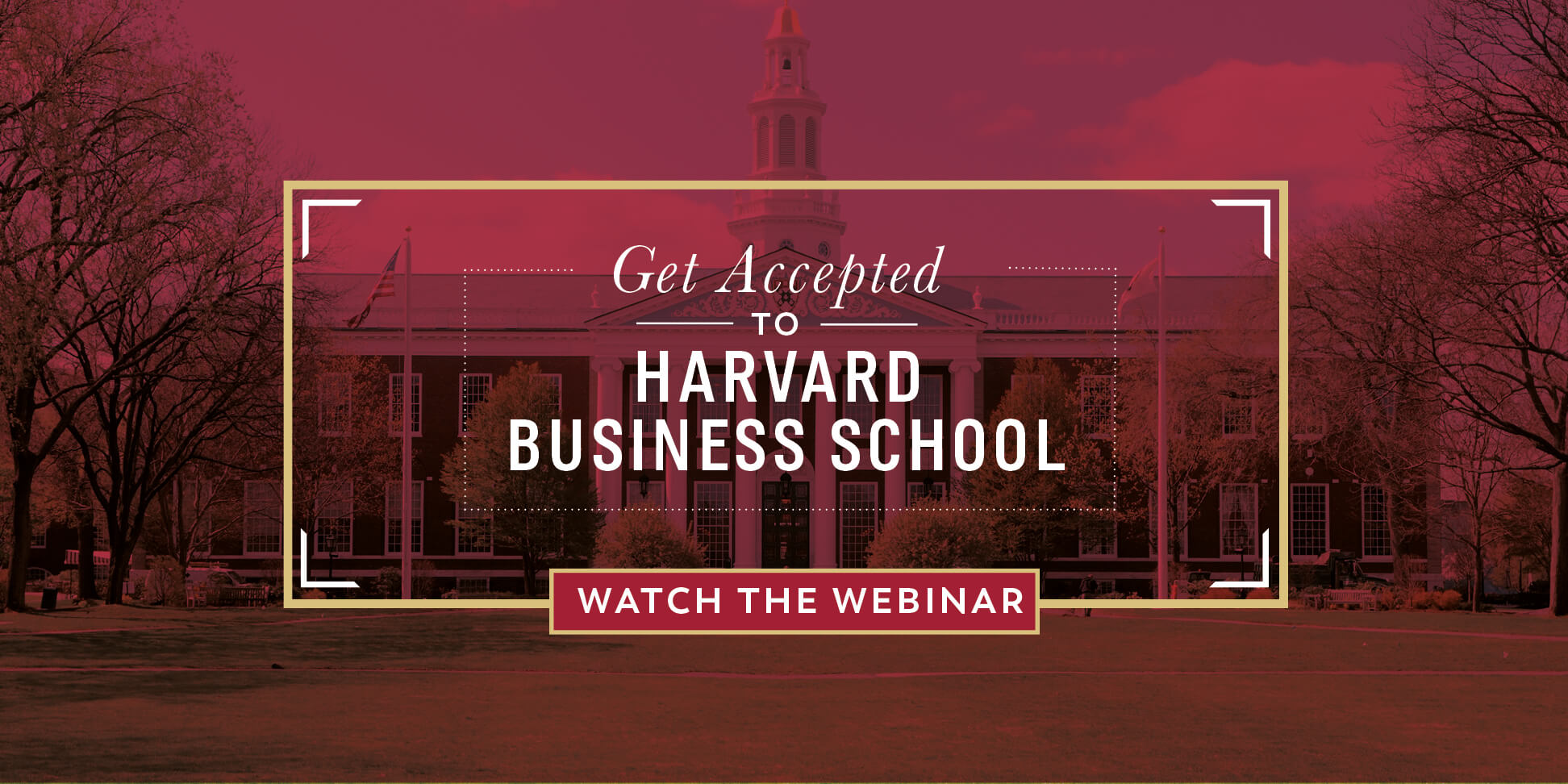 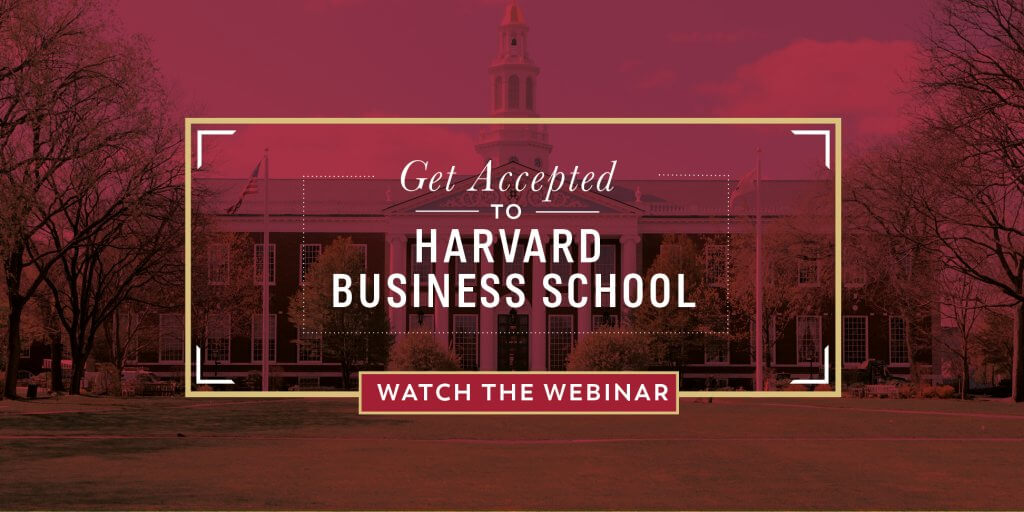 If you missed Get Accepted to Harvard Business School, or if you’d like to view it again, the webinar is now available on-demand. As you prepare for next year’s applications, learn the key strategies you need to approach HBS’s application successfully. How can you show that you’re a perfect fit? How can you ensure your application will stand out? How can you give yourself the best possible chance of acceptance? Accepted’s founder Linda Abraham will provide you with a proven strategic framework for a successful application when you view the webinar.   Tags: MBA Admissions The post Get Accepted to Harvard Business School – View Video Now! appeared first on Accepted Admissions Blog. |
| FROM Accepted.com Blog: Happy 4th of July! |
 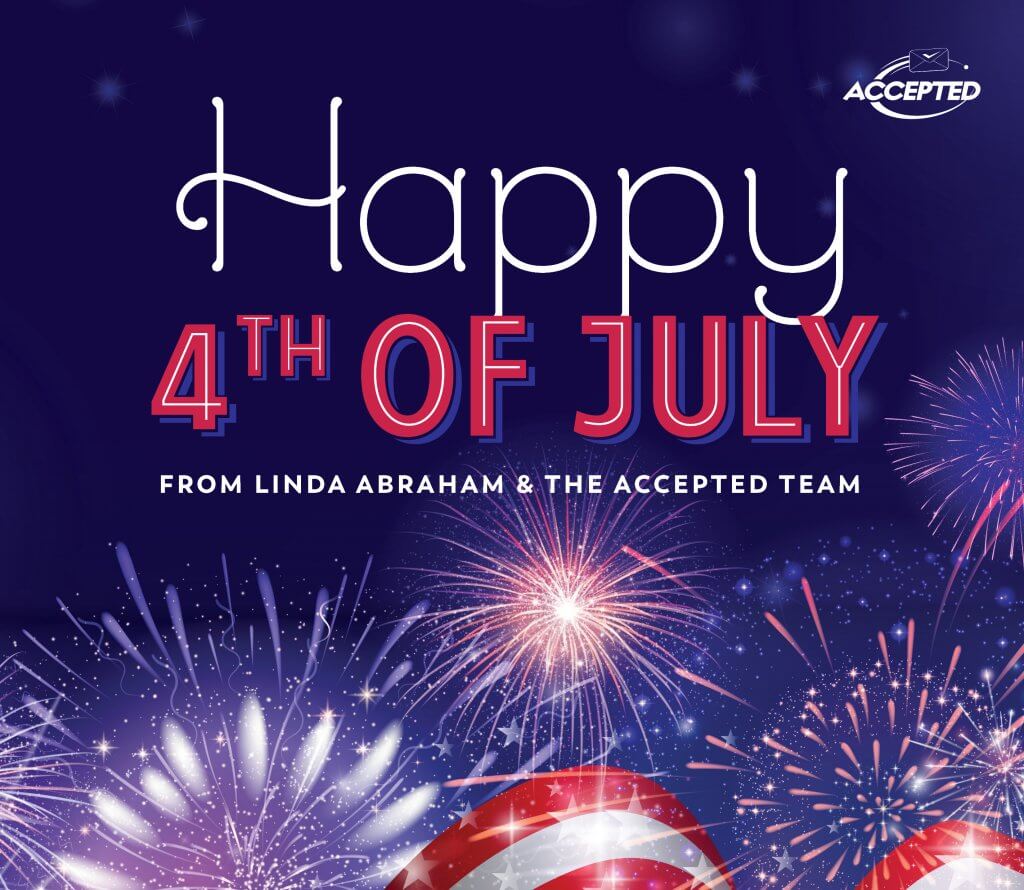  Tags: Admissions Consulting, College Admissions, Grad School Admissions, Law School Admissions, MBA Admissions, Medical School Admissions The post Happy 4th of July! appeared first on Accepted Admissions Blog. |
| FROM Accepted.com Blog: Do You Have What Stanford’s Looking For? |
  If you’re planning to apply to Stanford GSB, you know your application must be exceptional: when you’re competing for a spot at a top program that only accepts under 6% of its applicants, you need to stand out! How can you make a great case for admission? Step #1: Show that you’re a great fit. Step #2: Show that you stand out! Of course, there are other key strategies you’ll need too – and that’s why we’ve created our upcoming free, live webinar, Get Accepted to Stanford GSB, to guide you through a proven framework for application success. And because we know your time is valuable, we’ve packed it all into just one hour. Join us on Wednesday, July 25th at either 10am PT/1pm ET or 5pm PT/8pm ET (choose the best time for you). The webinar is free, but you must reserve your spot. Register Now:  Tags: MBA Admissions The post Do You Have What Stanford’s Looking For? appeared first on Accepted Admissions Blog. |
| FROM Accepted.com Blog: UC Berkeley Haas MBA Application Essay Tips & Deadlines |
  Haas, like several top MBA programs, is looking for a new dean to replace its dynamic, innovative dean, Richard Lyons, on July 1. He has served as dean for the last eleven years. I expect an announcement any day. Despite the impending change at the top, Haas is extremely difficult to get into. It has for the last three years been #3 in Accepted’s selectivity index, right behind Stanford and Harvard. While the acceptance rate and average GPA have remained pretty stable, Haas’ average GMAT has soared 10 points to 725 from the entering classes of 2015 to 2017. At the same time, while Haas has made it very clear that you need outstanding academics to get in, they will not compromise their values to maintain those stats. The Four Principles are taken very seriously by Haas’ administration and admissions team. You need to show you share and live by those principles if you are to receive serious consideration at Haas. The Four Principles are: • Question the Status Quo • Confidence Without Attitude • Students Always • Beyond Yourself Keep those principles very much in the forefront as you prepare your Haas application. My comments are in blue throughout. The black font represents quotes from Haas, which provide excellent resources and advice on their website. Haas School of Business Application Essays The Full-time MBA program annually enrolls approximately 300 diverse, talented, and creative future business leaders. We admit candidates from a wide variety of industries and backgrounds who demonstrate professional achievement, academic aptitude, and leadership potential. Our community is enriched by students who embody our Berkeley Haas Defining Leadership Principles: Question the Status Quo, Confidence Without Attitude, Students Always, and Beyond Yourself, and we seek candidates who will contribute to our distinctive culture. The admissions team takes a holistic approach to application review and seeks to understand all aspects of a candidate’s character, qualifications, and experiences. We will consider achievements in the context of the opportunities available to a candidate. Some applicants may have faced hardships or unusual life circumstances, and we will consider the maturity, perseverance, and thoughtfulness with which they have responded to and/or overcome them. All interested candidates are encouraged to apply. Haas MBA Essay #1 Tell us a six-word story that reflects a memorable experience in your life-to-date. Elaborate on why it is meaningful to you. (300 words maximum) First off, I strongly encourage you to watch the video and review the examples we’ve linked to. Then follow these steps: 1. Think about what you want Haas to know about you that isn’t covered in the other information that you provide. Realize that by asking this question, Haas is seeking to get to know you better. This is a great place to show fit with Haas and its Four Principles (or at least some of them). 2. Then choose the six words that best reflect this memorable experience and perhaps make them curious to know more. Haas says contractions are OK, and perfect grammar isn’t necessary. The “what” clearly isn’t nearly as important as the “why.” 3. The elaboration – the why – is where the rubber meets the road. You may have to briefly provide context so the reader will know what you’re talking about and elaborate on the significance of those six words. Most of those 250 words should be devoted to why the event is important and the meaning you ascribe to it. Please note that the six words and subsequent elaboration are supposed to focus on one experience, not your whole life or several experiences. Haas MBA Essay #2 Briefly describe your immediate post-MBA career goal, and discuss how it will put you on a path to a meaningful and rewarding career. (300 words maximum) Your answer, as Admissions Director Morgan Bernstein says in her video on the essays, should “connect the dots between what you’ve done in the past and what you want to do in the future.” To answer this question you need to know two things: 1. What you define as a “meaningful and rewarding career” 2. The post-MBA job that will start you down that path The essay could start with a future day when you are on that meaningful career and then flash back to your first post-MBA job. You could also include a brief paragraph reflecting why this career is meaningful to you. Alternatively, you can start with an experience, preferably an accomplishment that reflects one or more of Haas’ principles, and discuss how the experience shaped your desired career path, and specifically your understanding of “meaningful.” Then discuss the post-MBA job and the path you want to take after attending Haas. Haas MBA Optional Information #1 We invite you to help us better understand the context of your opportunities and achievements. 1. What is the highest level of education completed by your parent(s) or guardian(s)? • Did not complete high school • High school diploma or equivalency (GED) • Associate’s degree (junior college) or vocational degree/license • Bachelor’s degree (BA, BS) • Master’s degree (MA, MS) • Doctorate or professional degree (MD, JD, DDS) 2. What is the most recent occupation of your parent(s) or guardian(s)? • Unemployed • Homemaker • Laborer • Skilled worker • Professional 3. If you were raised in one of the following household types, please indicate. • Raised by a single parent • Raised by an extended family member (grandparent, aunt/uncle, niece/nephew, cousin) • Raised in a multi-generational home • Raised in foster care 4. What was the primary language spoken in your childhood home? 5. If you have you ever been responsible for providing significant and continuing financial or supervisory support for someone else, please indicate. • Child • Spouse • Sibling • Parent • Extended family member (grandparent, aunt/uncle, niece/nephew, cousin) • Other 6. Please elaborate on any of your above responses. Alternatively, you may use this opportunity to expand on other hardships or unusual life circumstances that may help us understand the context of your opportunities, achievements, and impact. (300 words maximum) Simply and honestly answer the short answer questions and then elaborate in #6 if relevant or use this essay to discuss hardships or “unusual circumstances” that are the context for the rest of the application. In providing that context, especially when talking about hardships overcome, provide enough information for the admissions committee to understand the hardship, but not so much that you end up writing a pity essay or you end up appearing somehow “damaged” or broken. Overcoming hardship can strengthen a person. That’s the kind of image you want to create if you choose to write on the topic. Yes, you may have experienced something difficult, maybe even tragic or terrible, but you have overcome this and are stronger as a result. The reader’s reaction? Admiration, not pity. Haas MBA Optional Information #2 This section should only be used to convey relevant information not addressed elsewhere in your application. This may include explanation of employment gaps, academic aberrations, supplemental coursework, etc. You are encouraged to use bullet points where appropriate. This optional essay is a restrictive optional. Only use it to provide context for events and outcomes, like a dip in grades or employment gap. You don’t want the admissions readers to (wrongly) assume something or imagine what caused that gap or dip. Just tell them succinctly what happened if you haven’t done so somewhere else in your Haas application. For expert guidance with your Berkeley Haas MBA application, check out Accepted’s MBA Application Packages, which include comprehensive guidance from an experienced admissions consultant. We’ve helped hundreds of applicants get accepted to Berkeley Haas’ MBA program and look forward to helping you too! UC Berkeley Haas 2018 – 2019 MBA Application Deadlines Application Deadline Decisions Released Round 1 September 27, 2018 December 13, 2018 Round 2 January 10, 2019 March 14, 2019 Round 3 April 4, 2019 May 9, 2019 ***Disclaimer: Information is subject to change. Please check with individual programs to verify the essay questions, instructions and deadlines.*** 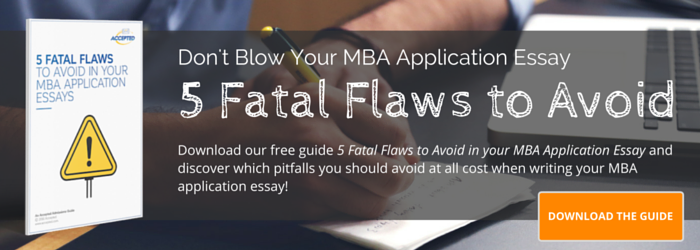  By Linda Abraham, president and founder of Accepted and co-author of the definitive book on MBA admissions, MBA Admission for Smarties: The No-Nonsense Guide to Acceptance at Top Business SchoolsWhy MBA?, a free guide to writing about your MBA goals • Up Close and Personal with Berkeley Haas at the 2017 AIGAC Conference • Different Dimensions of Diversity, a podcast episode Tags: MBA Admissions The post UC Berkeley Haas MBA Application Essay Tips & Deadlines appeared first on Accepted Admissions Blog. |
| FROM Accepted.com Blog: Schwarzman Scholars: For Global Leaders Interested in China |
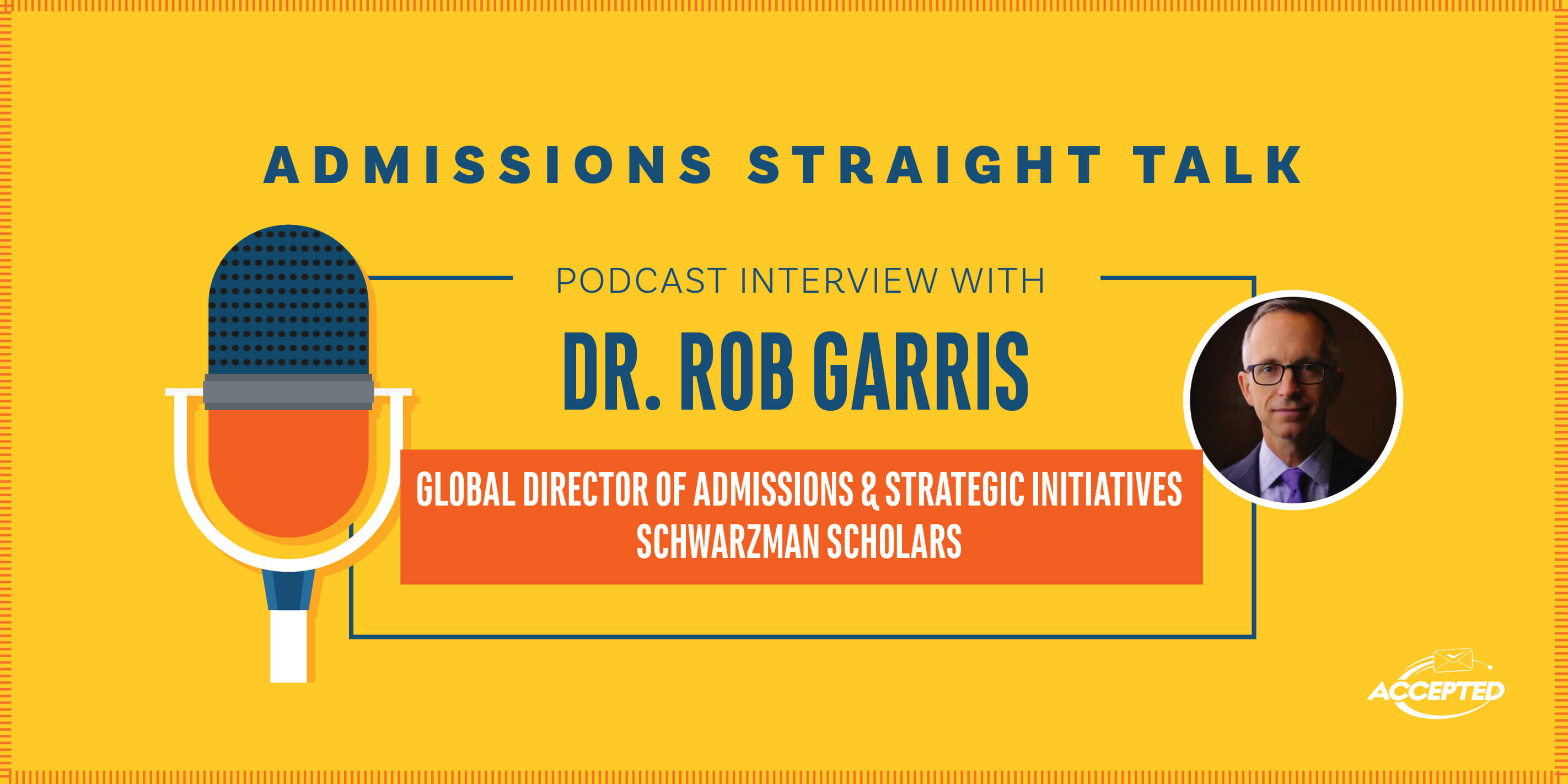  Gaining Leadership Skills & In-Depth Knowledge of China through the Schwarzman Scholars’ Program [Show Summary] Dr. Rob Garris, Global Director of Admissions for the Schwarzman Scholars Program, discusses the Schwarzman Scholars’ program and admissions policies. Through the program, participants from around the world earn a Masters in Global Affairs at Tsingua University in Beijing. The entire program is focused on providing the scholars with in-depth knowledge of China while developing their global knowledge and leadership skills. Modeled after the Rhodes Trust, Schwarzman Scholars provides full tuition, room and board, and a stipend to participants during the year of study. Dr. Rob Garris, Global Director of Admissions, Speak About the Schwarzman Scholars’ Program [Show Notes] Today’s guest, Dr. Rob Garris, earned his Ph.D in European History from UNC in 1998. While at UNC he also launched his career in academic administration when he worked as the Director for Educational Programs for UNC’s Center for European Studies. That was followed by other positions including a stint as Senior Associate Dean for Columbia’s School of International and Public Affairs and Managing Director of the Rockefeller Foundation. All these positions prepared him for his current role. Since 2014 Rob has worked as the Global Director of Admissions for the Schwarzman Scholars Program, where he oversaw the development of the Admissions Office for Schwarzman Scholars and has spearheaded recruitment efforts. Let’s start with the basics since there are probably listeners who aren’t familiar with the Schwarzman Scholars program. What is the Schwarzman Scholars program? [2:15] The Schwarzman Scholars program is an educational and leadership development program designed to ensure that decades from now there are people in leadership roles in every part of the world and in every major professional field who are better at what they do because they understand China and who also function together as a network and as an intermediary between China and the world. China is already playing an important role in many different aspects in global trends. We think it is important that people have factual knowledge of how China interacts with the rest of the world coupled with professional and interpersonal relationships so there can be much smoother flows of information between China and other major world powers. At Tsinghua there is a very strong academic program developed by Tsinghua and other universities around the world about how China relates to the rest of the world. In addition to the classroom experience, we give students incredible opportunities to learn outside of the university about China and its role– students travel around the country, visit with professionals in fields they are interested in, discuss topics including the environment, health, technology, and urban planning. We also match each scholar with a senior mentor in his/her field to learn in a firsthand way from someone who has been successful in that field. At the end of the year we help place scholars into an internship-like experience to continue learning in a workplace environment. We have relationships with 70+ institutions in Beijing so students can end their year with a very practical hands-on experience. Can you give us a bit of background on how it came into being? [7:44] The program was inspired by a particular moment in the professional life of Steve Schwarzman, cofounder and chairman of Blackstone. In 2007 when Blackstone was preparing for its IPO, the Chinese government contacted Steve to express interest in participating in the deal. Through the negotiations that resulted, Steve became very aware that many of the business and political leaders he turns to when trying to think through an important transaction didn’t have the same level of awareness of how the Chinese government went about making decisions, or factors driving participation in an IPO of a North American financial firm as compared to other major countries. He thought that was a dangerous situation – to not be knowledgeable about a country like China. He recognized the need for a new generation of leaders with a deep awareness of China. After a time he got to know China better and was introduced to Tsinghua. His natural instincts to use his philanthropy to address problems in particular through educational programs eventually led to the inspiration to build a new kind of program at Tsinghua inspired by Rhodes. Can you describe the Schwarzman Scholars admissions process? [10:28] That’s hard to answer on a specific level, but easy on a general level. Our program is designed to accommodate a wide variety of professional backgrounds. In our first three years of admissions, we have had a fairly stable set of interests from people in STEM fields, policy/politics/economics/business, and a smaller group with a humanities background. We are very happy to see the diversity, but it means the admissions process has to accommodate people with very different academic backgrounds and professional aspirations. We have designed the process to be as open as possible to accommodate different cultural and social backgrounds, connected with a focus on whether the candidate is likely to be a leader in the field they are interested in. We ask candidates themselves, “What is it in your experience that makes you think you are likely to be a leader in the field you care about?” We ask the admissions committee and interviewers to be focused on that pretty straightforward question, but to be as flexible as they can to the fact that leadership can look quite different in various areas in the world. The leadership theme informs everything in the admissions process, but is designed to be flexible to different kinds of leadership. When candidates ask what is the best thing to do to prepare to apply, I encourage them to not make all decisions based on Schwarzman Scholars, but I do advise them to devote time and attention to issues and organizations they care about. If they spend that time and energy on issues they care about, they will be a natural fit – they show dedication and initiative, interpersonal skills, and the ability to produce results. We care about the academic side of things as well, so I encourage prospective students to focus on doing well in the classroom, which of course is more straightforward to evaluate. Candidates with leadership tend to be really good in academic coursework as well. China interest/education is not part of the admissions process. The program is intended to find people who will be leaders in whatever area they will be in. For example, there could be an applicant who is a leader in energy policy focused on policy in US or Germany, who only now wants to include China, and that is fine. There are some scholars who do define themselves as China experts, but many more fit into the first category, with some other area of passion where they have come to realize they will be better in their field by having the China knowledge. Can you describe the application process? [18:23] The process is similar to other fellowship or graduate applications. There is an online application that is open right now with a deadline of Sep 27. After that deadline we go really quickly through a reading phase, where we have hundreds of readers around the world, and we direct applications to readers who will know and understand the culture and educational background of each candidate. In just over two weeks we assess over 4000 applications and select 400 people to come in for face-to-face interviews. The interviews are a little bit different from other programs. The candidate will spend one part of the day in a 25-minute interview with a panel of 5-6 who have already had very significant leadership experience – current or former CEOs, heads of state, heads of parliament, heads of non-profit organizations, who can draw on their own experience to understand this person. It’s a give and take conversation based on whatever people have written about in their applications. We have interview sites in Beijing, Bangkok, London and New York, and at our expense we fly candidates in for the interview. They spend the entire day with us. The in-person experience is important not just for the panel interview, but at mid-day all candidates come together in small groups for a problem-solving experience. In a team of 8-10, candidates work to solve a puzzle or problem. There we are looking not just for leadership skills, but the ability to collaborate and work as a team. There is also a luncheon where they sit with interviewers. So the day focuses on specifics of applications but also on the broader skills of interacting with peers. Out of the 400 applicants who come for interviews, roughly 140 will be offered a space. We are growing to a 200 number very slowly and intentionally. We are focused on group dynamics. We are watching interactions in each class to make sure we are creating an environment and community very much about learning from each other and making strong ties with each other. We don’t want to have a whole bunch of different communities who just happen to be living in the same building and studying the same curriculum. We watch that dynamic very closely and then make adjustments. Can people who have been out of school apply? [26:23] A candidate has to be younger than 29, and we’ve seen a shift in the last few years with more candidates who have been in the working world for a few years, from tech fields, government, consulting, and non-profits as well. The application requires a resume, two essays and one short answer question. There is also an optional video, correct? [27:31] Yes. The video, we make good use of – it is a one-minute opportunity to introduce yourself to the admissions committee. Think of it in a pretty relaxed way, as if you have just met a Schwarzman Scholar alum and have a minute to introduce yourself – you want to express who you are, what you are interested in, and why you want to be a Schwarzman Scholar. It is a chance for us to get a little sense of a candidate’s personality and how they might do in the interview. The first essay is without a doubt the part of the app we go back to most frequently, and candidates should focus the most time and attention there. In that essay, applicants should talk about what it is they are interested in, how they take initiative to act on that interest, and how they work with others on it. The second essay is very different. It is writing about a contemporary issue the applicant is interested in and written in a way they would for a class or publication in a student paper. This allows us to assess how well a person writes about topics they care about, and what kind of student they are likely to be. The resume is very straightforward, just a narrative of a person’s professional and academic experience. A leadership section in the resume is encouraged. How has the program evolved since you’ve now completed two full cycles? What have you learned? [31:46] For the program we’ve seen it’s very important to provide a lot more room for scholars to explore and create on their own. In the first year we over-programmed things. From our thinking we wanted to make sure people had time to settle in, had a solid structure for support, and then recognized as the year went on that a lot of the really strong bonds formed when scholars had to figure things out on their own. We have changed a number of things from orientation to the amount of classroom time to travel time to create open space for them to get to know each other and to take responsibility for their own learning experiences, and that has been really helpful and useful. Some changes have been more practical and logistical, like we’ve managed to work out calendaring quirks so that our scholars can go take other classes in the rest of Tsinghua and vice versa, so there is much more opportunity to get to know other students. We also initially created the internship as a part-time experience, but we’ve heard loud and clear that it is much more valuable to have a short and intensive experience at the end of the year to focus on the work rather than piecemeal it out. On the application front, there has been a conscious shift in the ratio of students to make US and international students more equal. We continue to debate the age limit, but we are keeping that in place for now. One other change is that in the interview process we now have standard structured questions that candidates should prepare for – we share before the interviews – but we wanted to have more consistency across interviews that take place and still have room in the interview to be free-flowing. What are Schwarzman Scholars doing after they get their degree? [36:39] We are still young so we don’t have defined patterns as yet, but we have seen some people want to combine their education with other forms of graduate education, about 20%. It is much more typical for people to work in the business world – technology, finance and consulting are the most represented areas. Fairly close behind are those working in various government or non-profit positions focused on policy issues. What kind of career placement or guidance is provide by Schwarzman Scholars? [39:22] We’ve had an enormous response from recruiters from a wide variety of fields. We have two career services colleagues in Beijing and one in New York working on employer relations in New York, London and other major cities. All senior leadership contributes with their network to help scholars in their job searches. In the non-profit and government world it is a much more networked approach. Can you speak about the collaboration developing between Rhodes Trust and Schwarzman Scholars? [41:24] In our first year Rhodes offered advice on how to think about selection process. This has rolled out into a lot of shared thinking about education, leadership, and how to develop in a population of talented young people. We have a Rhodes Schwarzman Leadership Program during orientation which is now expanding out, and we are collaborating on alumni programming. We see the collaboration continuing to grow. How do you see the program evolving going forward? [42:59] I think it will change pretty significantly. We are fortunate in that we’ve built a structure that is pretty adaptable. With international faculty who rotate in and out, we are able to pivot pretty quickly as subjects or interests change. We constantly ask ourselves what the critical issues are that leaders will need to understand, and we think a lot about some of the innovations in genetics, AI, manufacturing, and how that will impact curriculum. We want the curriculum to be as up to date as it can be. Having recognized there is real value for students to explore and create on their own, we also want Scholars to have more ownership of their experience so are also doing more thinking on that.  Related Links: • Schwarzman Scholars • Schwarzman Scholars Application Essay Tips and Deadlines • Admissions Consulting Services Related Shows: • When Global Business is the Goal • Wharton Lauder: An MBA/MA that Prepares You for Global Business • UVA MS in Global Commerce: 3 Continents, 2 Masters, 1 Amazing Year Subscribe:   Podcast Feed 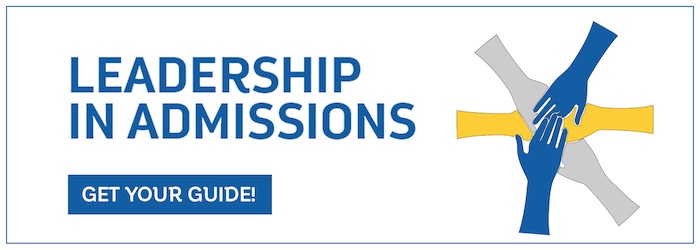 Tags: Admissions Straight Talk, Grad School Admissions, MBA Admissions The post Schwarzman Scholars: For Global Leaders Interested in China [Episode 267] appeared first on Accepted Admissions Blog. |
| FROM Accepted.com Blog: Understanding Stanford GSB’s Interest in Personal Qualities and Contributions |
 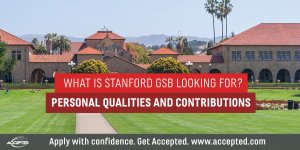 What are the qualities that Stanford GSB is looking for as they build their class? How do successful applicants stand out from the crowd? At a school as competitive as Stanford, it’s a fact that many smart, accomplished applicants won’t get in—so how can you demonstrate that you have that “it” factor? Let us walk you through Stanford’s evaluation criteria and give you some advice. Personal Qualities and Contributions In an MBA essay on a meaningful personal experience: • Applicant A describes his ascent of Machu Picchu; we learn that it was awe-inspiring, challenging, and required excellent teamwork; he concludes by asserting that he was moved on a deep level and grew from the experience. • Applicant B takes us on a walk around her block. We learn about the struggles of her neighbors in the face of gentrification and her mixed feelings as one of the gentrifiers; how she informally refereed an argument among residents about the stop-and-frisk policy; the diversity of canine life on the block and the blossoming friendship between her pug and a neighbor’s Rottweiler. Personal Qualities We conclude from these essays that Applicant A spends a lot of money on personal fulfillment, lacks imagination, relies on banalities, and relishes physical challenges; and that Applicant B is alive to the richness of daily life, addresses ambiguity head-on, has humor, is compassionate, is attentive, and cares about meaningful issues. Point: Our personal qualities flow from and mirror our character. And when it comes to personal qualities, be assured, Stanford will prefer those of Applicant B – even though Applicant A’s topic is superficially more dramatic – because of the quality of character they reflect. Unlike Applicant A, Applicant B’s personal qualities represent an engaged, observant, thoughtful person. Certainly, there’s nothing wrong with climbing Machu Picchu or with writing about such an experience – but it’s not the fact of doing it that will impress; rather, what you have to say about it, arising from your personal qualities and reflecting your unique perspective that will catch the thoughtful admissions reader’s eye. • Don’t struggle and strain for “unique” things to say. • Rather, for Stanford, share your life. Open it up, let it dance or swagger or sashay or skip or march or cartwheel, whatever your style is. Contributions Now the contribution part. Because Applicant B is attentive to and cares about her surroundings, she can respond and contribute to the daily life of her neighborhood. Again, nothing particularly dramatic or unique; mainly interactions with neighbors. But they’re quality interactions. She cares. She has specific questions and concerns and feelings and insights – which become her offering. She can bring this abundance, this world, this humanity “to the table.” You just know this person will be a big contributor wherever she is. She doesn’t have to explain that fact – it’s obvious! Follow her example. Let your personal qualities come alive by sharing what’s meaningful to you in your essays (and elsewhere if/as possible in the application). Don’t explain that you will contribute; show that you do contribute. It’s simply who you are. Applying to Stanford? Check out our MBA Admissions Services and work one-on-one with an expert advisor who will help you create a stand-out application for Stanford GSB. Click here to learn more about how we can help you get accepted.   Cindy Tokumitsu has advised hundreds of successful Stanford applicants, helping them gain acceptance to Stanford along with other top MBA and EMBA programs in her 15+ years with Accepted. Want Cindy to help you get Accepted? Click here to get in touch! Related Resources: • 5 Fatal Flaws to Avoid in Your MBA Application Essays, a free guide • Stanford GSB MBA Application Essay Tips & Deadlines • Tone Up Your Writing: Confidence vs Arrogance Tags: MBA Admissions The post Understanding Stanford GSB’s Interest in Personal Qualities and Contributions appeared first on Accepted Admissions Blog. |
| FROM Accepted.com Blog: Is 10 Days Per Business School Application Enough? |
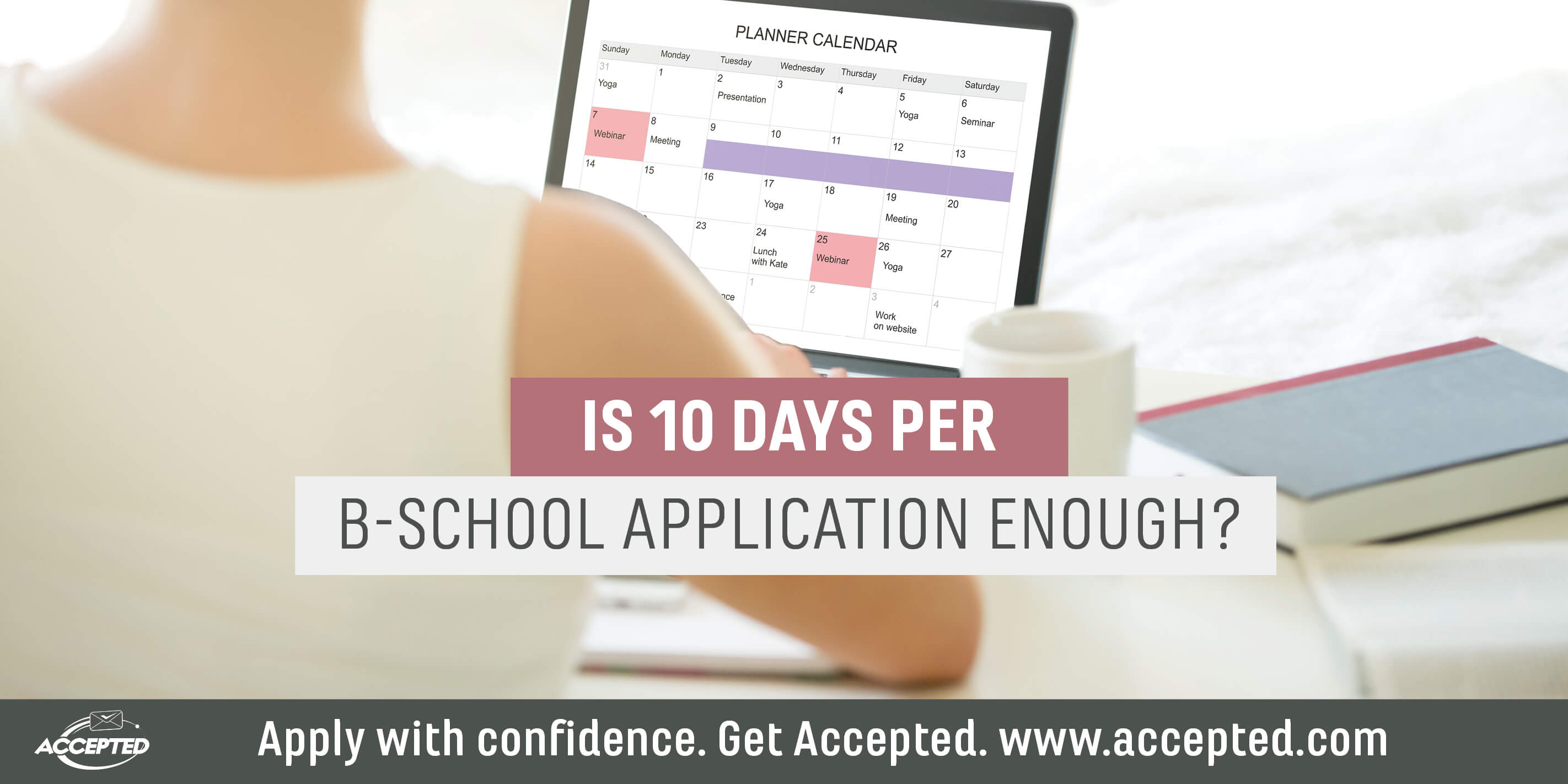  There are a number of steps involved in the MBA application essay writing process: contemplating the questions, choosing the topics, and crafting a collection of short stories that tell a tale and appeal to an admissions committee. Each of these steps takes time. But HOW MUCH time do you actually need? A day? A week? A month? I think the best way to maximize efficiency is to give yourself plenty of time – about one to two weeks – per application. The following tips should help you get organized: 1. Do the easy stuff first. Before you sit down to focus on your essays, make sure that you’ve already taken care of the application basics – get your GMAT squared away, school selection finalized, transcripts sent out, recommenders lined up, resume polished, etc. There are two benefits to this: First, you’ll be able to focus better on your task at hand after you’ve already crossed off so many things on your to-do list; and second, you’ll have a much clearer idea of your admissions profile once you’ve tackled these objective application elements. 2. Reserve more time for your first application. The first essay and application almost always take the longest to complete. It rarely comes naturally to applicants to think and write about their accomplishments and failures, career background and goals, leadership and teamwork experiences, and turning points in life. Getting used to writing in such a way takes practice. After you’ve forced yourself to think and write in this new way, you’ll find subsequent essays less challenging. 3. Leave time for the tricky ones. There’s always a tricky essay that holds up the schedule, and that essay is different for every applicant. You may blow through a 500-word career goals essay only to get bogged down in a 200-word culture-shock essay. Mental blocks don’t adhere to a schedule. Be prepared for the unexpected! 4. Understand that life happens. A project at work suddenly requires overtime or travel, a family need suddenly fills a weekend, a recommender suddenly has no time to write a recommendation. Unanticipated events may cause you to put your application on hold, even after diligent and steady progress, leading you to delay submitting several applications until Round 2. So yes, set a schedule, try to stick to it, but recognize that an application is ready when it’s ready. Recognize that submitting a GREAT application in the second round is far better than submitting a mediocre application in the first round. Mediocrity doesn’t get accepted to top, highly selective business schools. Accepted admissions advisors are available to help you achieve your admissions goals. Check out our MBA Application Services, work one-on-one with your dedicated admissions pro, and create a winning application that you can submit proudly…and on time! 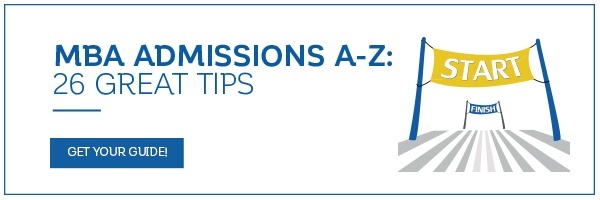  Related Resources: • 5 Fatal Flaws to Avoid in Your MBA Application Essays, a free guide • Three MBA Application Poisons and Their Antidotes, a short video • Sample MBA Application Essays Tags: MBA Admissions The post Is 10 Days Per Business School Application Enough? appeared first on Accepted Admissions Blog. |
| FROM Accepted.com Blog: Understanding Stanford GSB’s Take on Demonstrated Leadership Potential |
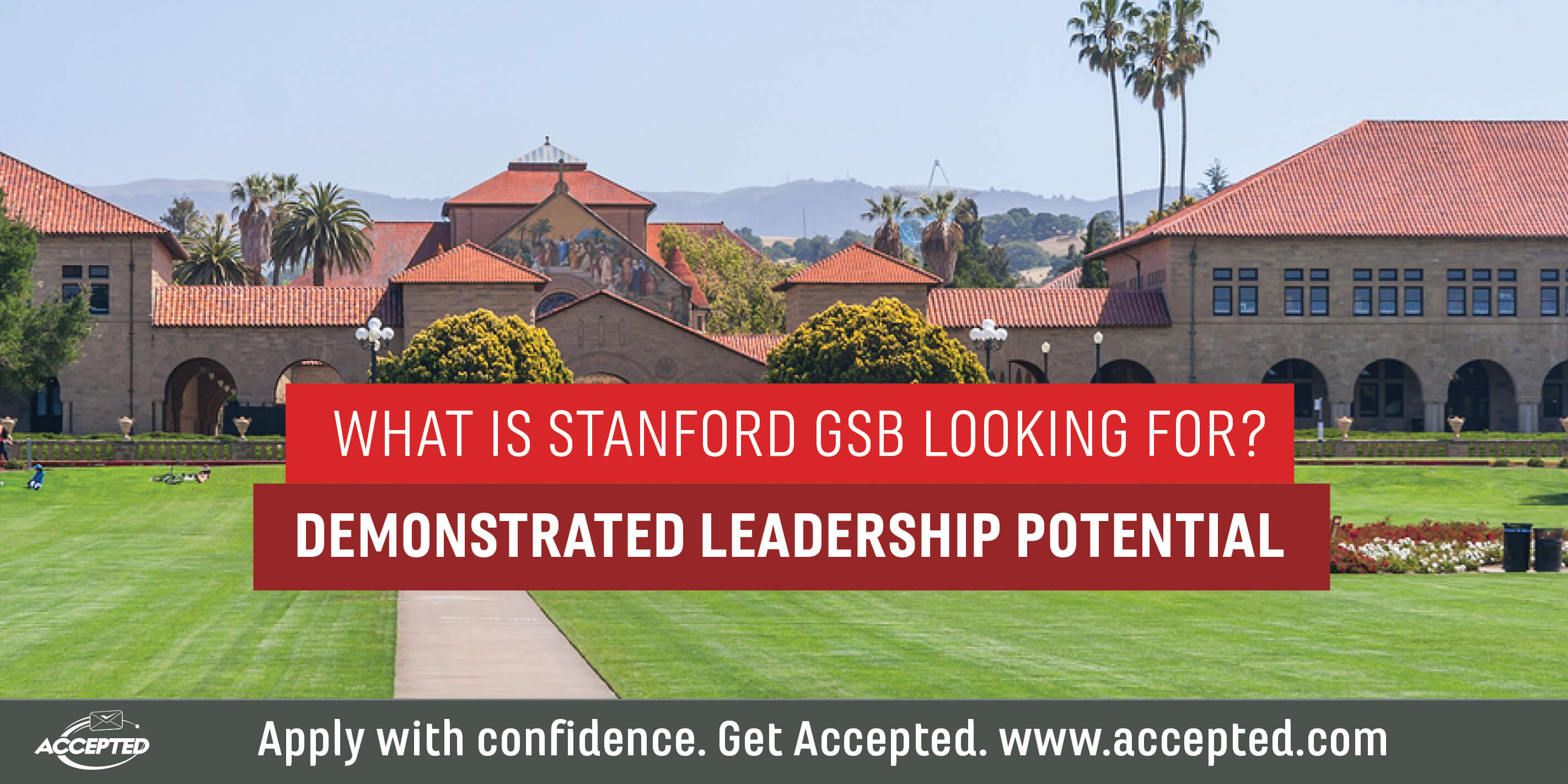  What are the qualities that Stanford GSB is looking for as they build their class? How do successful applicants stand out from the crowd? At a school as competitive as Stanford, it’s a fact that many smart, accomplished applicants won’t get in—so how can you demonstrate that you have that “it” factor? Let us walk you through Stanford’s evaluation criteria and give you some advice. Demonstrated Leadership Potential Of course, Stanford GSB seeks demonstrated leadership potential – don’t all b-schools? And naturally you’ve got leadership, or you wouldn’t be applying to Stanford. But. There are some unique nuances to Stanford’s conception of leadership that are essential to understand in order to portray it effectively in your application. Let’s break the phrase down word by word, starting with the core principle. Leadership. Leadership starts with your personal character in Stanford’s eyes —your own “values and ideals.” Whatever change you’re guiding the client to achieve, or whatever vision you’re advocating, or whatever project you’re driving the team through Hades to complete on time – your character informs it in some way, shape, or form. Even if the project in question is not of deep importance to you – still, how you lead the group will reflect your character. To provide appropriate and meaningful leadership, you must have core values or ideals and be guided by them – including as you lead. GSB’s preferred leadership is essentially value- and ideal-driven, what it calls “directed idealism.” Potential. Even if you are already a leader per the above definition, you’re not satisfied. You know that improving will only enable you to achieve more of what you value – therefore you actively seek to grow as a leader. You are open to critique and feedback, you are resourceful, you are humble, and you are hungry to learn. Demonstrated. Concrete evidence that convinces the adcom to conclude that you will grow as a leader and provide leadership in the future. You must demonstrate both leadership and potential to grow as a leader. For the former, provide this evidence by portraying experiences in your application boxes, essays, resume, and (if you provide some inputs for your recommenders) recommendations that reflect your leadership to date. For the latter, in these same application components frankly reflect on where you are in your leadership development – you understand what parts are innate to you, and where you need to improve. So “demonstrated leadership potential” is actually rather complex. Spend some time and effort on a strategy to integrate these points into your entire application. Check out the first post in this series, Understanding Stanford GSB’s Core Value Of Intellectual Vitality. Applying to Stanford? Check out our MBA Admissions Services and work one-on-one with an expert advisor who will help you create a stand-out application for Stanford GSB. Click here to learn more about how we can help you get accepted.   Cindy Tokumitsu has advised hundreds of successful Stanford applicants, helping them gain acceptance to Stanford along with other top MBA and EMBA programs in her 15+ years with Accepted. Want Cindy to help you get Accepted? Click here to get in touch! Related Resources: • Leadership in Admissions, a free guide • Stanford GSB 2018-19 MBA Essay Tips & Deadlines • Understanding Stanford GSB’s Take on Demonstrated Leadership Potential Tags: MBA Admissions The post Understanding Stanford GSB’s Take on Demonstrated Leadership Potential appeared first on Accepted Admissions Blog. |
| FROM Accepted.com Blog: Planning on Stanford GSB? Plan for This! |
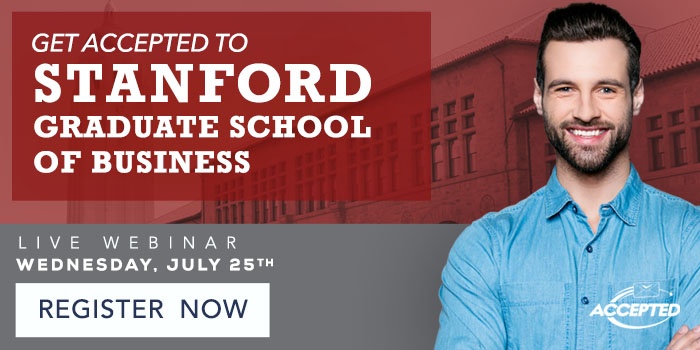  We know that for many MBA wannabes – especially those with entrepreneurial aspirations – Stanford beckons. How can you approach the application thoughtfully and put yourself in the best position to succeed? What does Stanford GSB value in the application process? We also get it: applying to top schools is stressful – and you’re looking for clear, direct information and advice. That’s exactly what you’ll find in our free, live webinar, Get Accepted to Stanford GSB. In just one hour, Accepted’s founder and CEO, Linda Abraham, will guide you through a proven strategic framework for application success. Plus, now is a great time to prepare your Round 1 Stanford MBA application. The webinar is timed to help you do just that. Save your spot and mark your calendars for Wednesday, July 25th at either 10am PT/1pm ET or 5pm PT/8pm ET (pick the best time for you). Don’t miss it! Register Now:  Tags: MBA Admissions The post Planning on Stanford GSB? Plan for This! appeared first on Accepted Admissions Blog. |

|
|